Prologue
Photon/Galaxy is an archetype that debuted in the ZeXal era and is piloted by Kaito Tenjo in the Yu-Gi-Oh anime. It first appeared in the TCG in Photon Shockwave all the way back in November 2011. Since then, it has received support in multiple sets and most recently, Legendary Duelists: Season 2. With the release of Galaxy-Eyes Afterglow Dragon, Photon/Galaxy has received a lot of hype in being a strong casual deck. In this article, we'll take an in-depth look at some of the most playable cards, strategies, variations and combos.
Note: This review is NOT a full archetype review. It will consist of what I think are some of the best card choices of and for a Pure Photon/Galaxy deck. If you wish to listen to this article, this article features a video counterpart (on Youtube) that can be located at the end of this article! Please consider checking it out for an exclusive deck profile with my personal Photon/Galaxy build.
Playstyle & Deck Building
Strategy
The Strategy of a pure Photon/Galaxy deck is simple. When going first, you want to summon beefy monsters that have protection or disruption effects to prevent your opponent from developing. You want to then follow-up with a powerful turn two to defeat your opponent quickly. When going second, you want to exploit weaknesses in your opponent's board. Look for a chance to quickly end the game. Luckily, Photon/Galaxy is great at doing this since they pack a variety of threats to force/bait your opponent’s responses. After exhausting your opponent’s responses, use a finisher such as Draglubion or Prime Photon. Overall, Photon/Galaxy plays like a glass cannon-style deck. If you can hold the past turn one, you’re usually in a winning position. If you board is broken, then you’ve probably lost.
Strengths
Galaxy-Eyes / Photon is an archetype that can put up multiple disruptions going first and is great at exposing weaknesses going second. It excels in creating powerful monsters (often with built-in protection) that make it difficult for your opponent to play. It also has great OTK potential with beefy monsters and strong finishers. Combos in the deck often include interchangeable cards and even the worst of hands can usually end on at least 1-2 threats on the field.
Weaknesses
As an archetype that plays around many cards that have specific summoning conditions, hands are subject to bricking and consistency is always an issue. Although the deck plays many searchers, most combos are subject to your opener going through, which isn’t always likely. Grinding is also difficult as the deck offers little recovery and revolves around multiple card combos. The deck also struggles to play past Nibiru unless it chooses to setup in an un-optimal way. Although the archetype has a fair ceiling for what it could do, the floor is also quite steep which makes great hands good but bad hands terrible or even unplayable.
The Main Deck Ratio of 2
While reading this, you may have noticed that a lot of cards are played at two. While cards like Vanisher and Afterglow are important, the reason they are played at two is because you can only use them once per turn. They are also all searchable which makes it usually easy to search the card you’re missing. While you want to see these cards in your hand, you also don’t want multiple copies because they’ll clog until the following turn. In a meta where you want to make every card have immediate impact, playing two is safer than playing three if you don’t absolutely need to see the card.
Deck Building, Theory and Variations
Photon/Galaxy is a deck that can be built in a variety of ways. While the most common build is to play it as a pure OTK deck, it also has midrange options. When building the deck, keep your options open and don't get locked into certain cards. Certain cards that seem good such as Chaos Dragon Levianeer and Galaxy Cleric, while good on paper, often perform much worse in actual gameplay.
Don't be set on Photon/Galaxy being an OTK deck either. While the deck does have many OTK elements, It also has cards that are good in controlling the board. The archetype can also utilize cards such as Gozen Match to slow down the game in matchups such as Virtual World and Lost World Dino. Cyber Dragons was thought to be purely an OTK deck until one player proved it could be midrange, and another threw in 20+ traps.
Lastly, play the deck the way you would enjoy it. If you like huge cool-looking Dragons that can OTK, play them! If you'd rather control the field with Photon Lord and Harbinger, you can do that too! At the end of the day, Photon/Galaxy isn't something meant to be super competitive and if you aren't having fun playing it, then why are you playing it to begin with? Good Luck, and enjoy the rest of the article!
Cards, Options & Ratios
Monsters
Galaxy-Eyes Photon Dragon
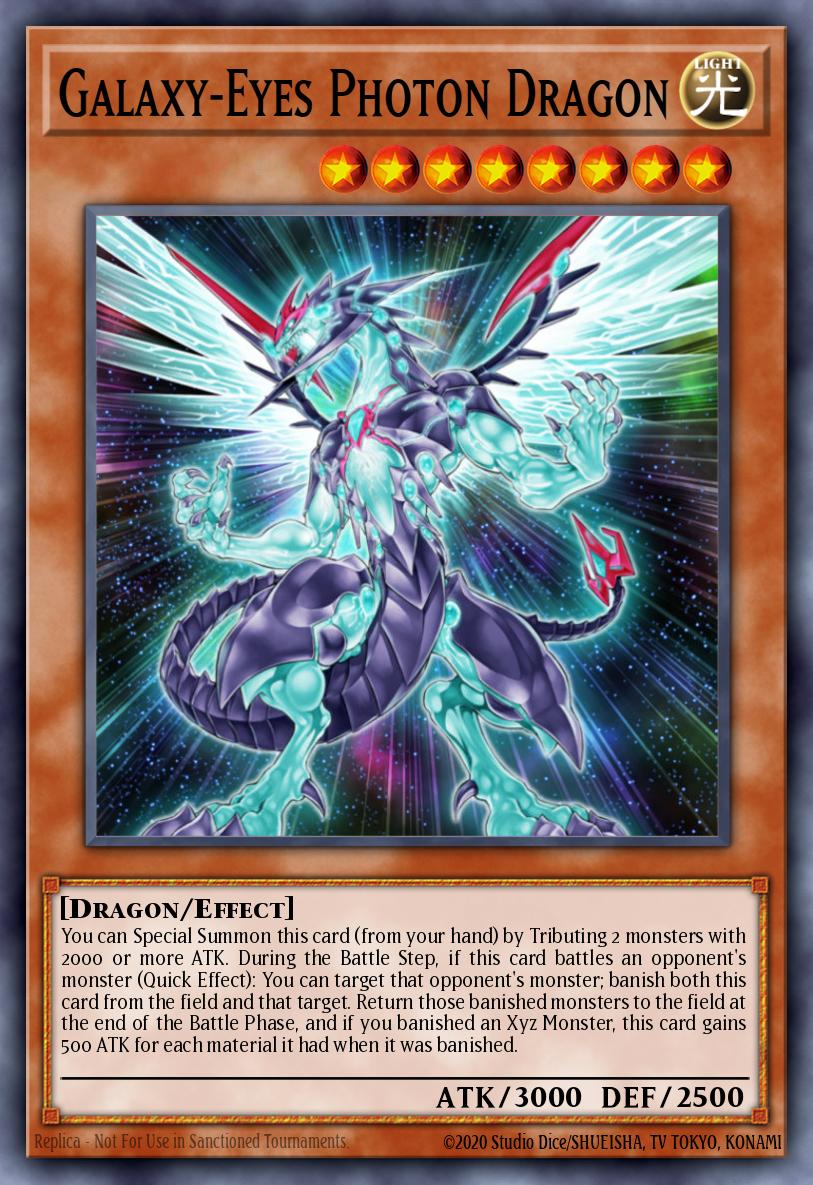
Galaxy-Eyes Photon Dragon is the heart and soul of the archetype. It’s included in almost all your major combos and is necessary for the full power of some of your XYZ monsters. Examples of this include Prime Photon which needs GEPD as a material to do its full damage or Photon Lord which needs a Photon monster as a material to gain its protection effect. GEPD can also be special summoned by tributing two monsters with 2000 or more ATK. This sometimes comes in handy where you really need to get it onto the field. It also has a nifty effect to remove itself and its battle target from the field until the end of battle phase. This effect, although rarely used can temporarily remove troublesome monsters such as Borrelsword Dragon (who cannot be destroyed by battle).
3-Of : GEPD is an integral combo piece and needed to advance your play. It combos with almost every part of your deck and you’ll find yourself summoning it a lot. Therefore, playing three is necessary in order for the deck to operate.
Photon Orbital
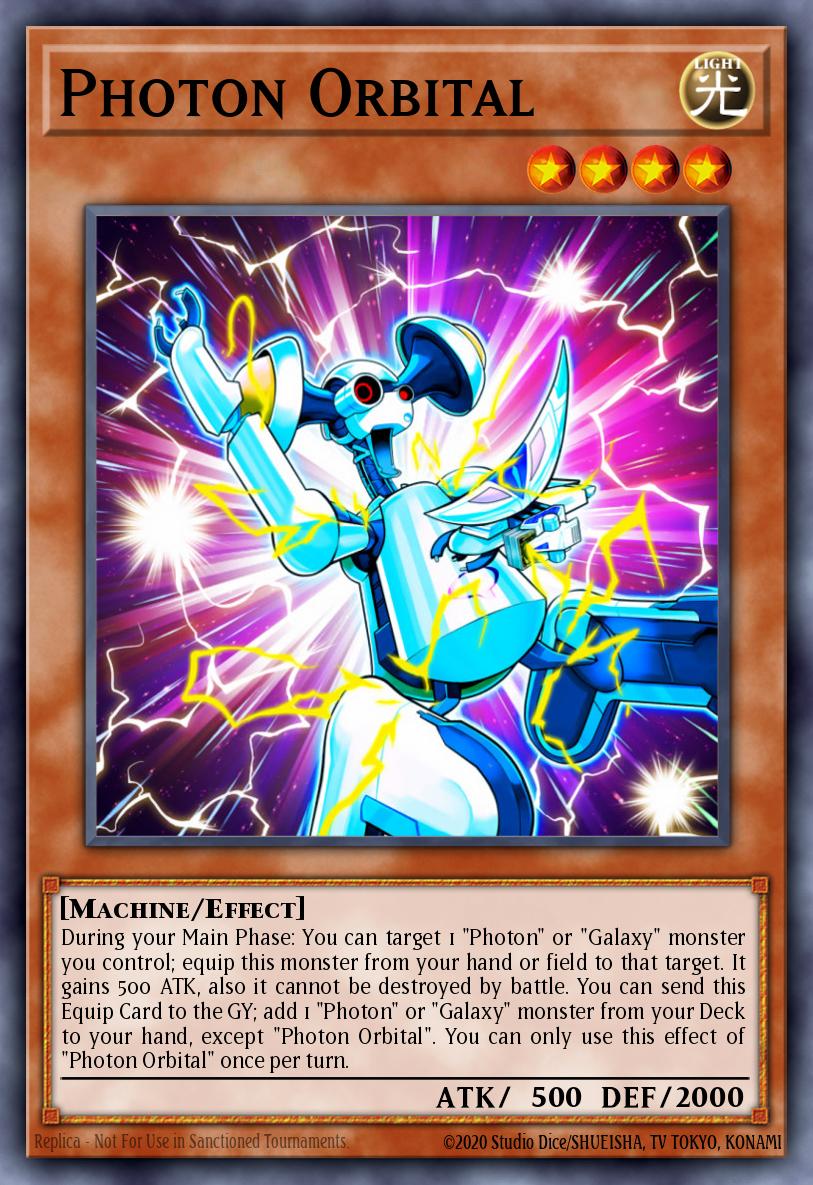
Photon Orbital is the search card for Photon/Galaxy. By sending it as an Equip Card to the GY, it lets you add one Photon or Galaxy monster from your deck to your hand. This is great as Photon/Galaxy is a combo archetype where one extra combo piece can make the difference between a good field and no field. Orbital also gives the attached monster 500 ATK and protection from battle. This synergizes with Starliege Photon Blast Dragon, giving it 2300 ATK, protecting it from battle and with its own effect. Orbital can also be equipped via Union Carrier which gives it easy accessibility from the deck.
3-Of : Photon Orbital is good since it’s a substitute for a combo piece. Playing it at 3 will allow you to see it most often without needing to summon Union Carrier. This lets you save your monsters for Galaxy-Eyes Solflare Dragon or Starliege Photon Blast Dragon.
2-Of : Playing Photon Orbital at two is also okay since it can be used through Union Carrier. Doing this will result in making your good hands stronger but your weaker hands worse.
Photon Vanisher
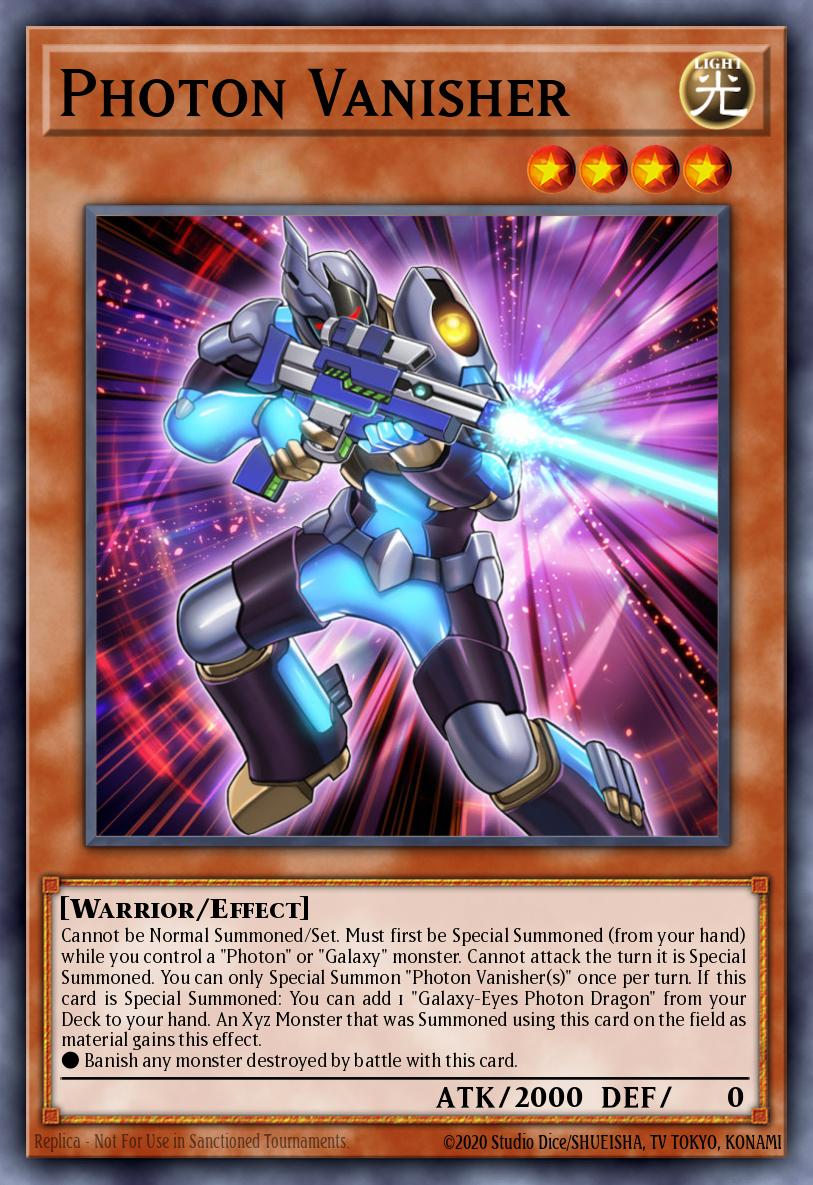
Photon Vanisher is a Level 4 extender that adds GEPD from your deck to your hand. It also has an effect where a monster summoned using it as an XYZ material gains an effect that banishes any monster that it destroys through battle. However, this effect is usually irrelevant due to the lack of offensive Rank 4s that will be able to take advantage of this. The most common way to use Vanisher is to XYZ into Starliege Photon Blast Dragon to summon the GEPD you just searched.
3-Of : Vanisher is important because it searches Galaxy-Eyes Photon Dragon. Playing 3 will allow you to see it more often without need to search it. As a result, you get to see GEPD more often. However, this will also increase the likelihood of you seeing 2 in the same hand.
2-Of : Vanisher can also be played at 2 because it can be searched through a variety of cards. This will decrease the chance of you seeing 2 in the same hand but also decrease the chance of you seeing it at all.
Photon Thrasher
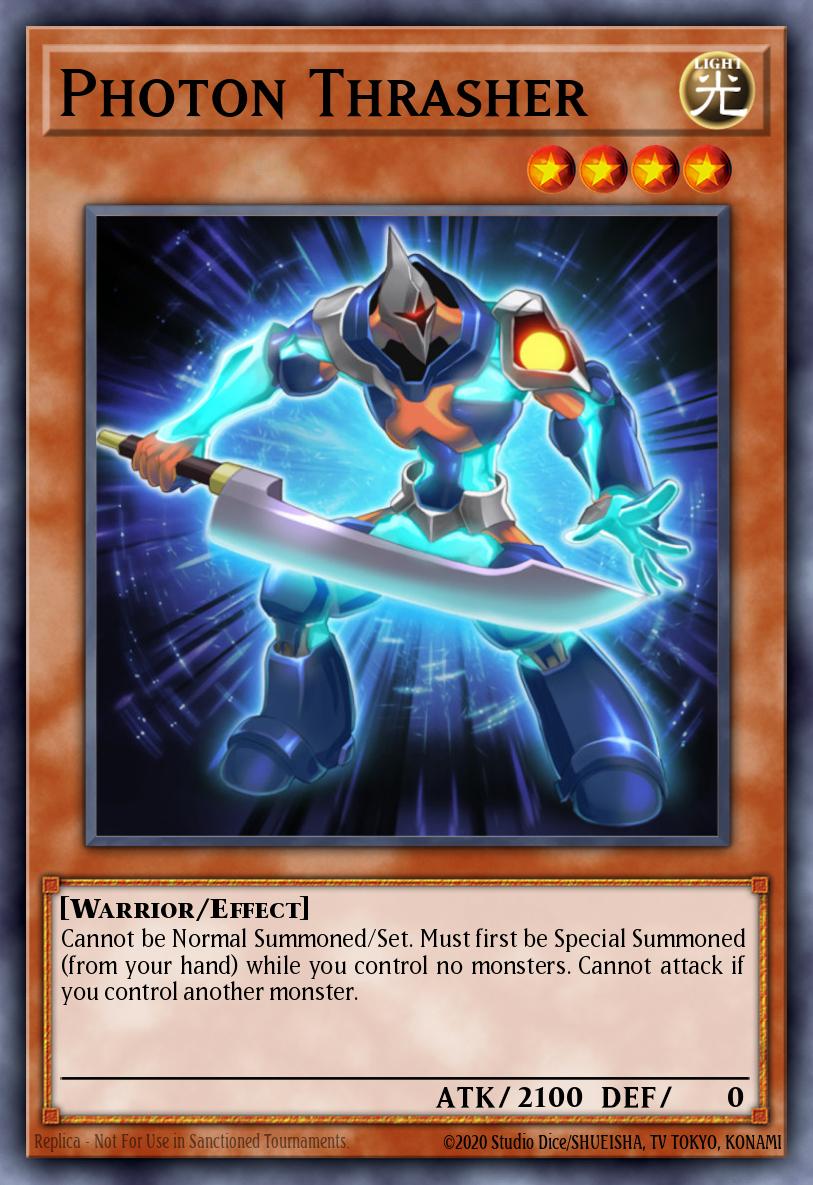
Photon Thrasher is a Level 4 extender that can be Special Summoned if you control no monsters. It’s used as a starter to get a Photon monster on board. This is important because most of your other cards require you to control a Photon or Galaxy monster. After Thrasher hits the field successfully, you can start branching into more plays such as using Orbital to search or summoning Vanisher and Advancer. Thrasher also has 2100 ATK which lets it run over troublesome monsters such as Inspector Boarder.
3-Of : Starters are important since they're what allows you to start play. Playing Photon Thrasher at 3 will allow you to see it more often which increases your chance of being able to play. However, like Vanisher, it also will increase the chance of you seeing 2 in the same hand.
2-Of : Thrasher follows the same principle of Vanisher where it can be searched through a variety of ways. Unlike Vanisher though, the deck has more starters than just Thrasher which gives you more reason to play it at 2.
Photon Advancer
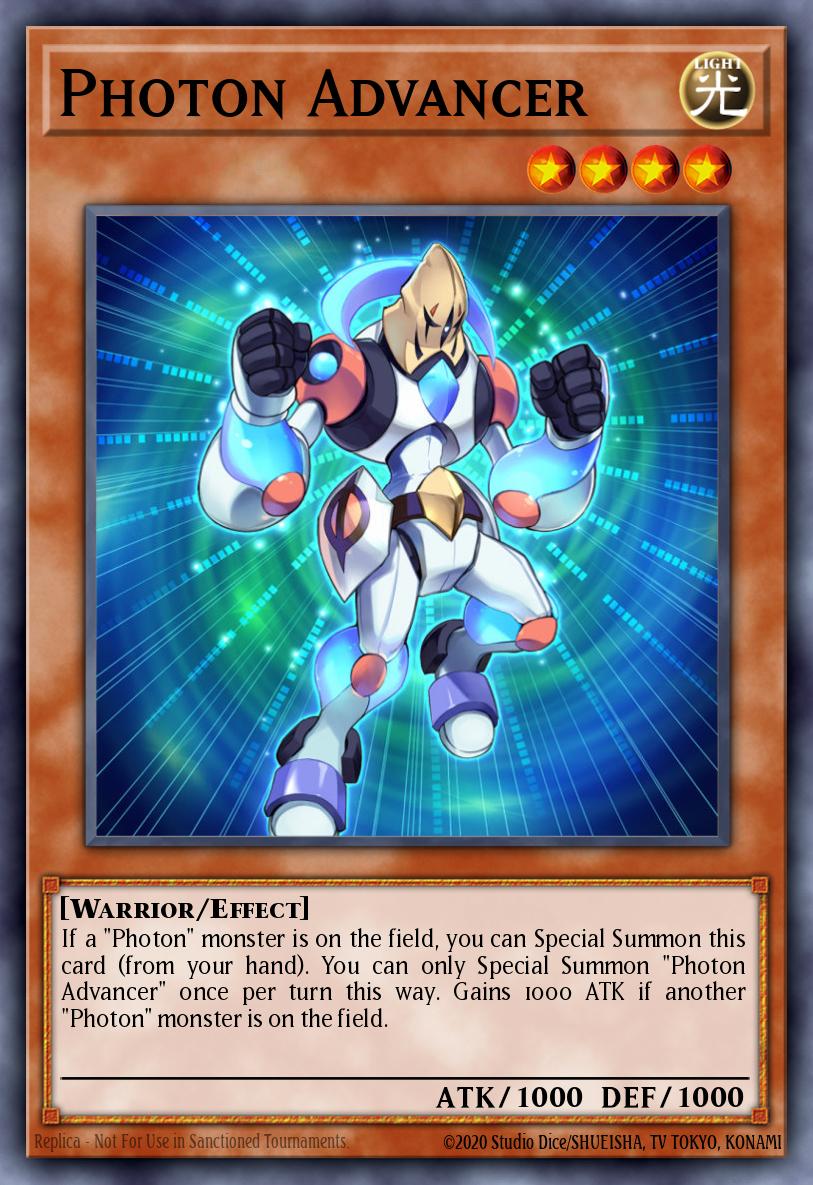
Photon Advancer is a level 4 extender that can be special summoned if a Photon monster is on the field. It gains 1000 ATK if you have another Photon monster and is mainly used to turbo out Starliege Photon Blast Dragon. Advancer is also a normal summon in the cases you aren't able to see one of your starters.
2-Of : Advancer is an extender that helps make summoning Union Carrier, Blast Dragon and Solflare easier. If you feel like you don't see it enough at 1, consider playing 2.
1-Of : Advancer is usually played at 1 because its another card you don't want to open multiples-of. It can only be special summoned once per turn using it's own effect and this makes having multiple clog. Another reason Advancer isn't played more is because Diana the Light Spirit is generally a superior extender in most situations.
Galaxy-Eyes Afterglow Dragon
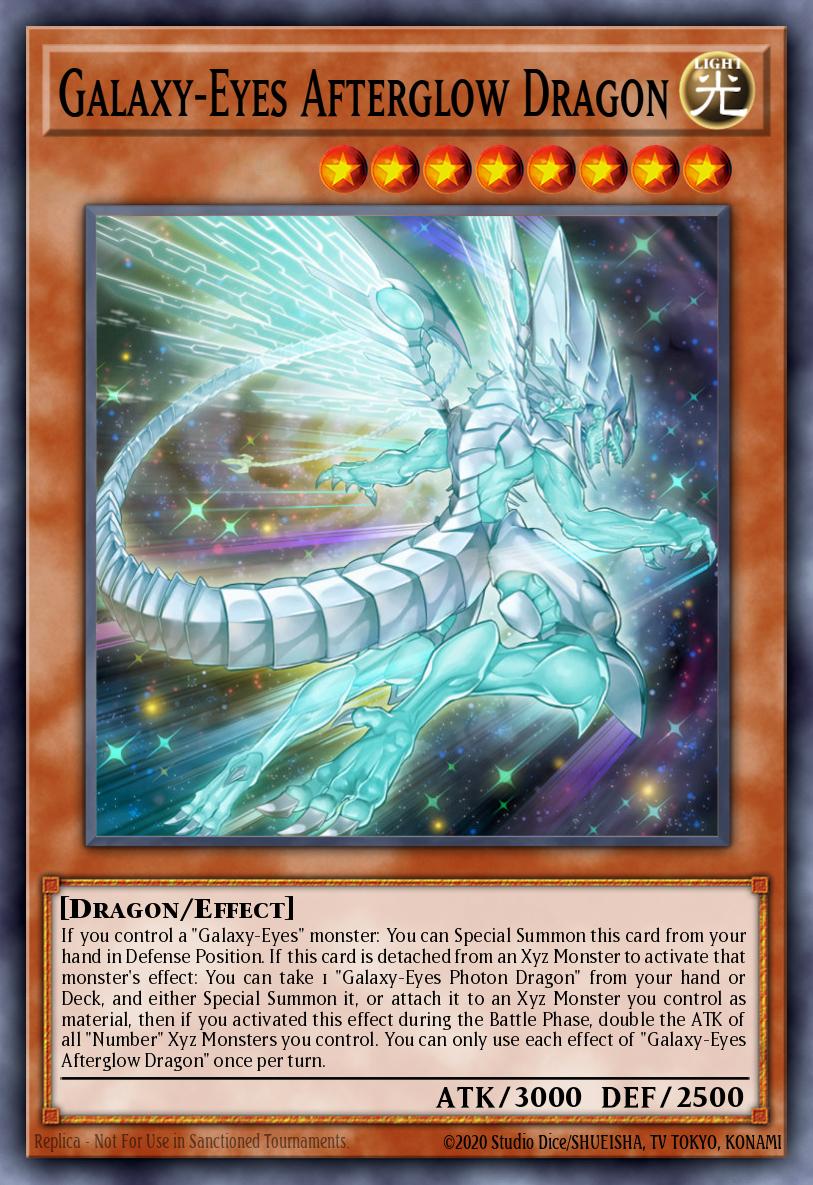
Galaxy-Eyes Afterglow Dragon is a new Level 8 extender/OTK battery released in LDS2. Its release greatly increased the deck’s OTK potential and also provides more turn 1 options. Afterglow is also great for OTKs because it doubles the ATK of all Number monsters you control when used during the Battle Phase. This makes your Photon Lord 5000 ATK and your Prime Photon 11200 ATK! Afterglow can also summon or attach GEPD as a XYZ material.
2-Of : Playing Afterglow at 2 will make it less cloggy in your hand. Unlike the Level 4 extenders, Afterglow can be searched with Galaxy Soldier and also discarded with Trade-In. This makes getting Afterglow to your hand easier while also making seeing multiple not as bad.
1-Of : You can also play Afterglow at 1 to help ensure it will brick less. Doing this requires more careful management as Afterglow is difficult to retrieve once it's in the GY. Though you can fetch it with Solflare, most of the time you want to be fetching Galaxy Knight instead.
Galaxy Soldier
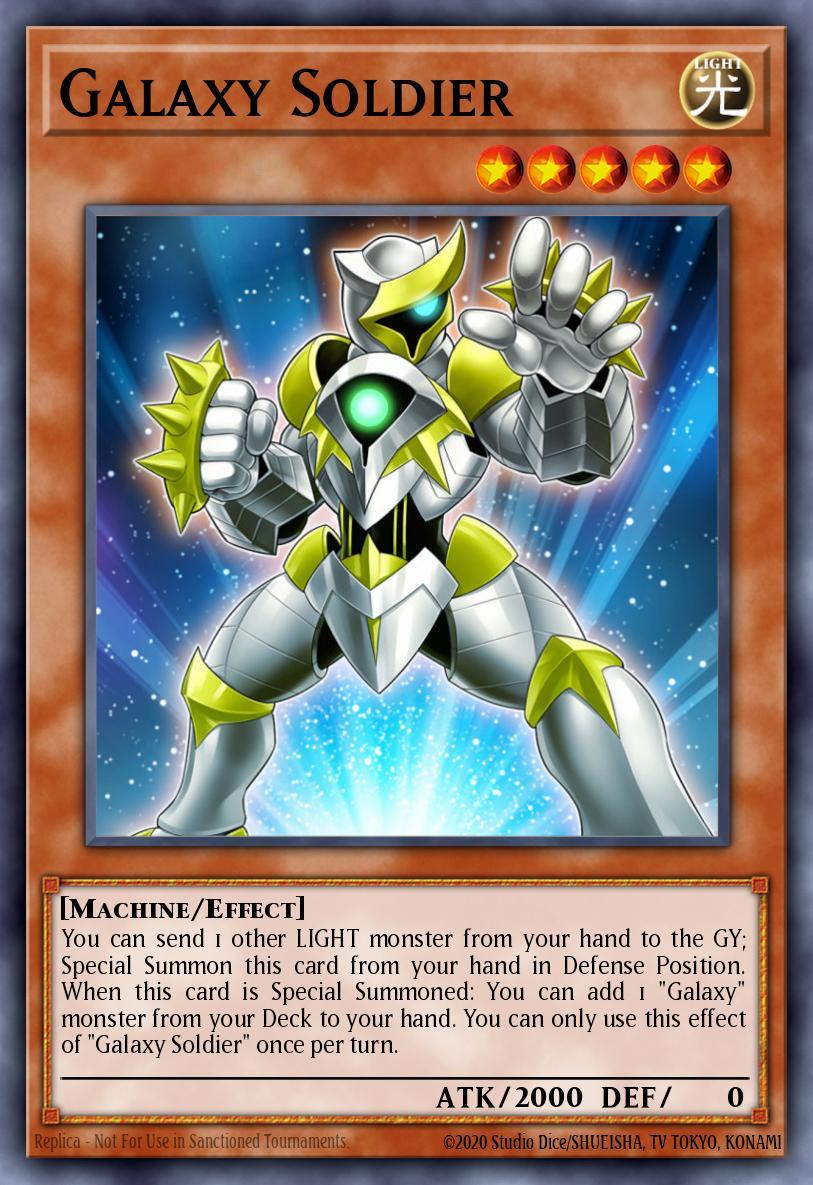
Galaxy Soldier is a Level 5 extender that searches for a Galaxy monster when it’s special summoned. This effect can activate through the use of Galaxy Expedition. Galaxy Soldier can also be used as a starter since it's a special summon that doesn't require you to have any monsters to use. Galaxy Soldier is good since it’s a card that gets you to your combo pieces. Its most common targets are Galaxy Knight, Afterglow or another Soldier.
3-Of : Galaxy Soldier should be played at 3 since it’s a non-OPT extender that also searches your combo pieces. It can be used to discard excess combo OPT monsters and get GEPD to the GY.
2-Of : In a few variations, playing Soldier at 2 is accepted since you'll rarely use all 3. Though.. I personally recommend playing 3.
Galaxy Knight
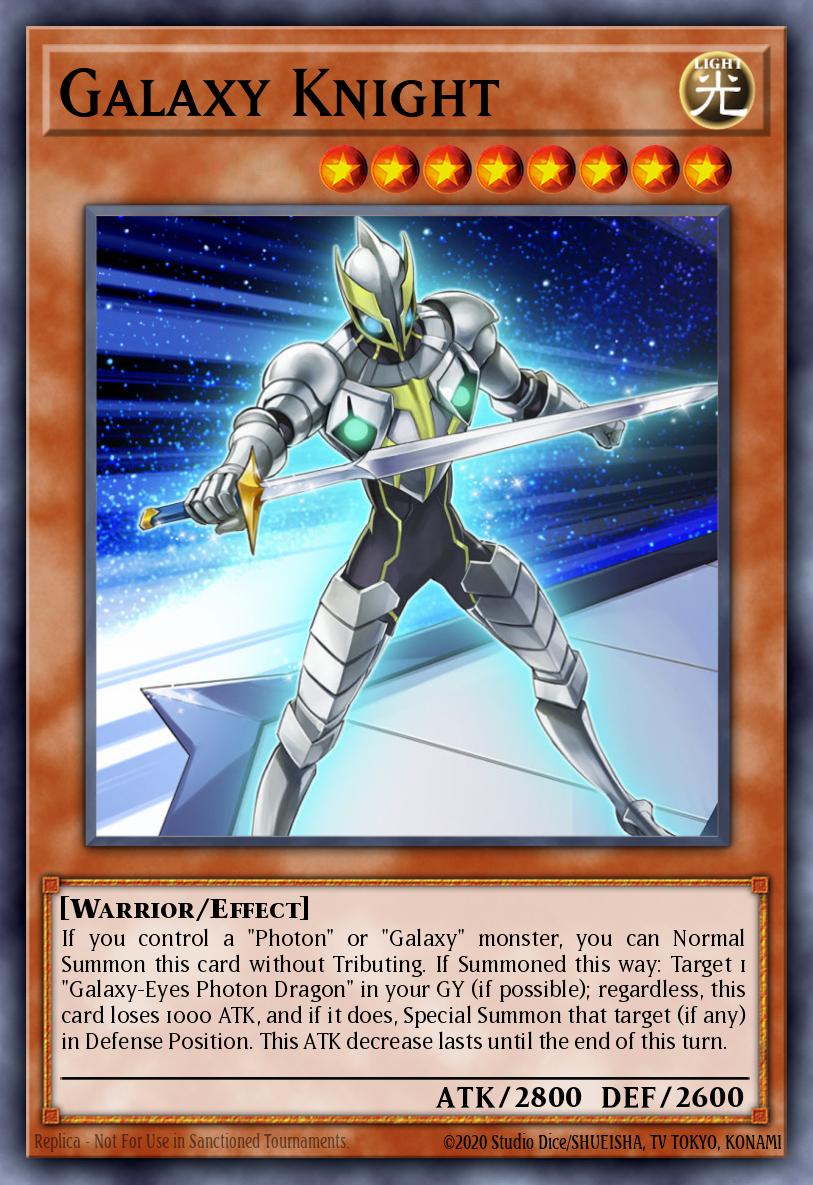
Galaxy Knight is a one card Rank 8 which can be normal summoned without tribute if you control a Photon or Galaxy monster. Knight is a good normal summon to end your combo after setting up. The idea is to usually summon Knight after GEPD is in your GY to end on Photon Lord or another Rank 8. Knight can also pull off surprise OTKs with Draglubion and is a great top deck.
2-Of : Galaxy Knight should be played at 2 since there’s multiple ways to get to it. Galaxy Soldier is the most common way, but it can also be summoned through Galaxy Expedition. Knight can also be returned to your hand from the GY with Solflare. Playing 3 will cause it to clog too much as you never want to open multiple normal summons in this deck.
Galaxy Brave
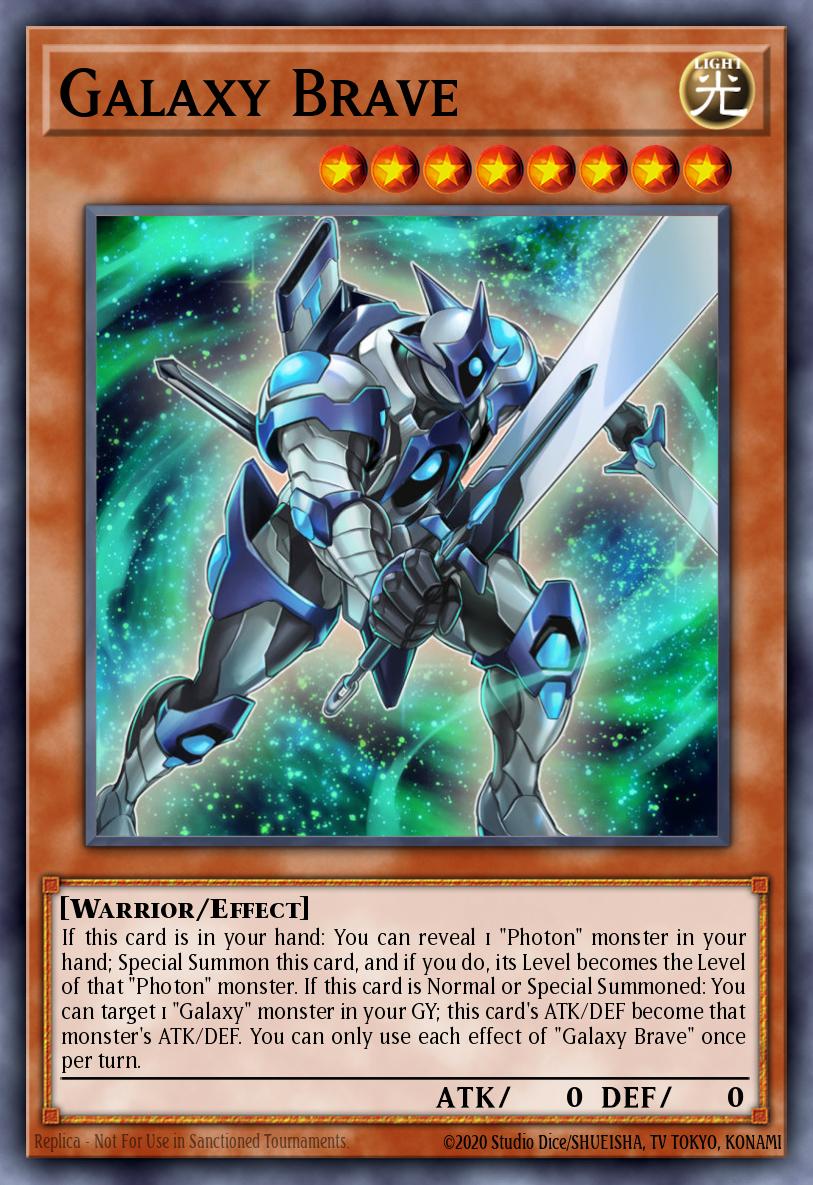
Galaxy Brave is a Level 8 extender that can change its level based on the monster revealed for its summon. It’s also an extra attacker dependent on what monsters are in the GY. Brave is a solid card as it can manipulate its level to what you need. It’s also a potential starter that works great alongside Vanisher and Orbital.
Note: When using Brave, keep in mind that it requires you to reveal a Photon monster but can only gain the attack of a Galaxy monster. This is important since you can't reveal Galaxy Soldier to make Brave a Level 5.
1-Of : Brave is a solid card but not a card you want to see excessively. It’s played at 1 so you won’t draw multiple, decreasing the chance of bricking. It’s also searchable through Galaxy Soldier if necessary.
Galaxy Cleric
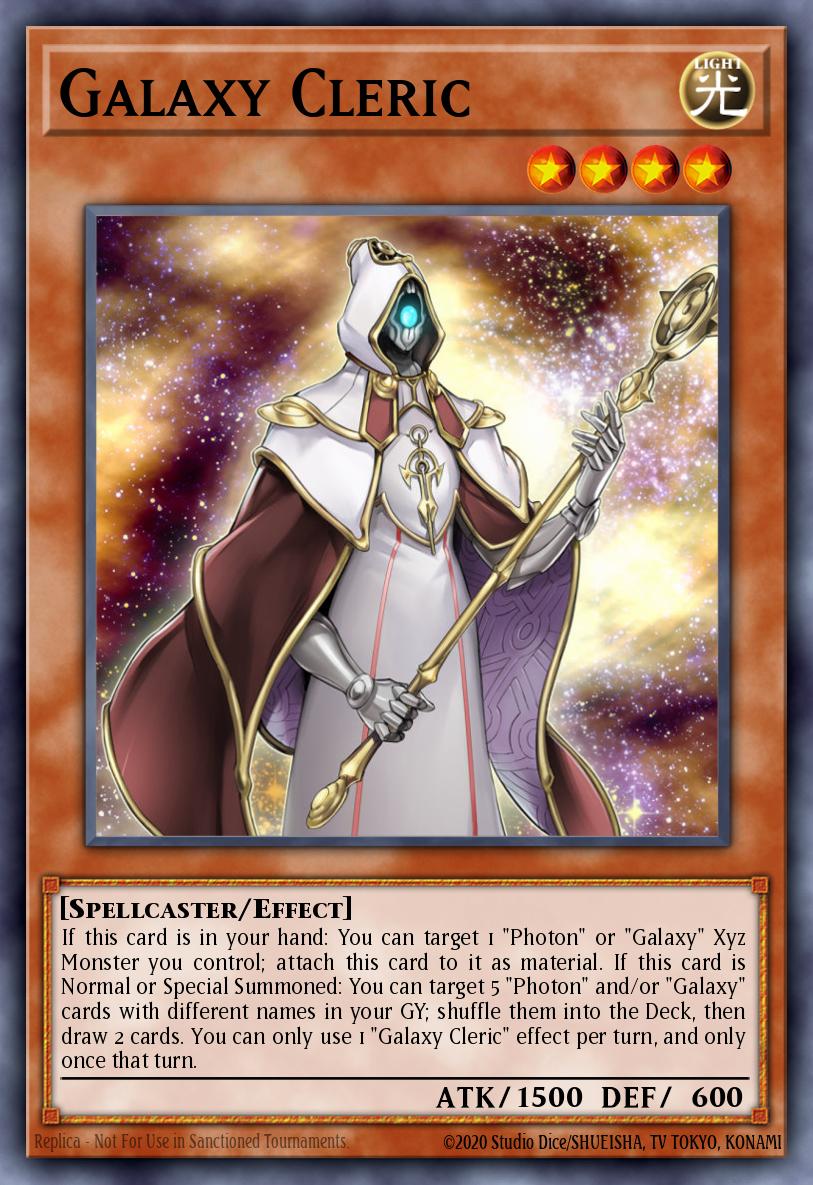
Galaxy Cleric is a Level 4 monster that is mainly played for grinding. Upon summon, Cleric lets you shuffle 5 Photon and/or Galaxy cards with different names from your GY into your deck to draw 2. This effect, while good on paper, is difficult to pull off in actual play as it’s not easy to get 5 cards into the GY on demand. This is because most of your monsters become XYZ materials. Galaxy Cleric is also an un-ideal option for normal summons since it doesn’t increase the pressure on your board. This is a problem because Photon/Galaxy is an archetype that needs to constantly pressure the opponent on the board with big threats. Galaxy Cleric can also attach itself from the hand to a Photon or Galaxy XYZ monster you control. This effect isn’t usually relevant unless you plan on transforming your XYZ monster into a Zeus.
1-Of : Cleric is a good option to have for slower games. It can recycle resources and also put back other 1-of cards you might play. Zeus is also stronger in slower games as they drift more towards board control rather immediate OTKs.
0-Of : Cleric, although good might be too slow for your meta. Your normal summon will most often be going towards Galaxy Knight and summoning Cleric just doesn’t seem good enough in an archetype where your normal summon is so important.
Galaxy Wizard
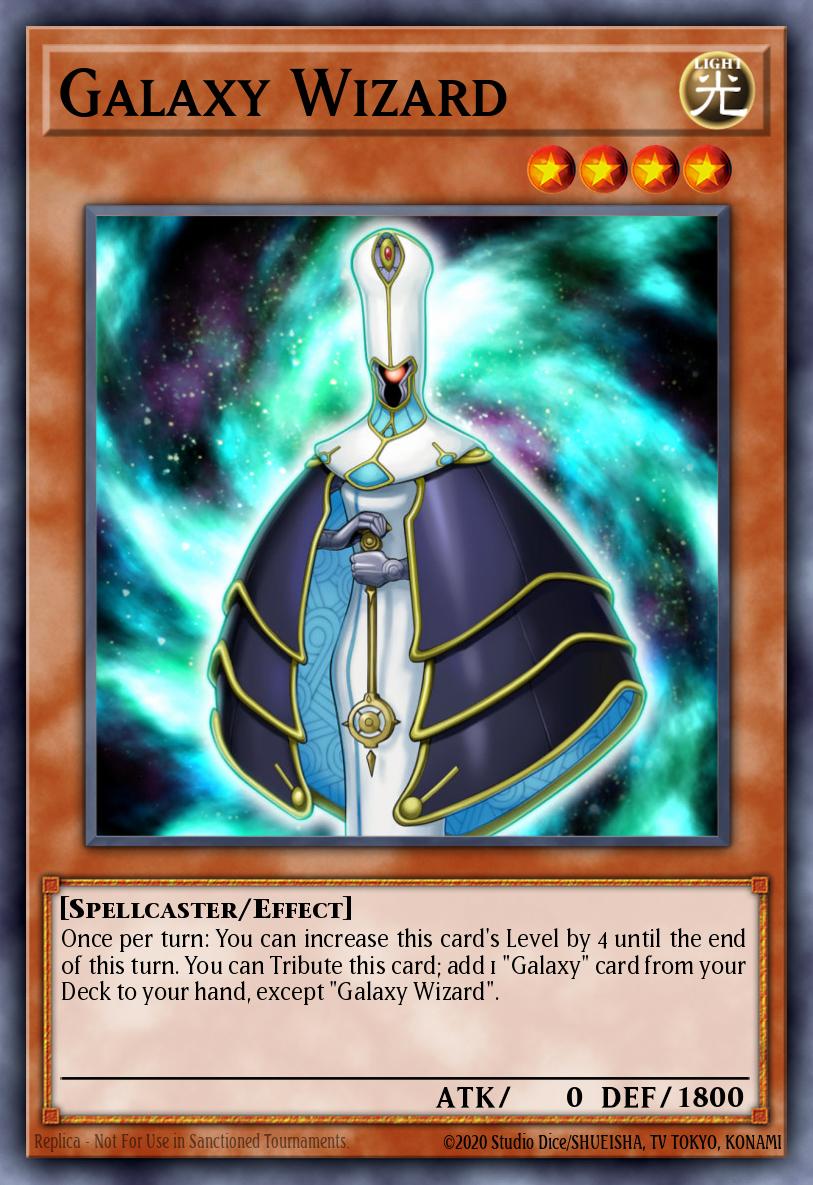
Galaxy Wizard is a Level 4 that can tribute itself to search a Galaxy card from your deck. It can also increase its level by 4 which can make it easier to activate Galaxy Expedition. Wizard is also the only main deck card that can search for Galaxy S/T. The downside to this is that it utilizes your Normal Summon which we have already stated to be very important.
2-Of : Playing Wizard at 2 increases your floor while decreasing your ceiling. This is because it means you’ll see a normal summon more often but also open with multiple normal summons more.
1-Of : Playing Wizard at 1 makes it an option but not something you plan to rely on. Wizard does have its uses in searching out cards like Galaxy Trance.
0-Of : Sometimes, Wizard feels really bad to draw because summoning it means you won't be able to normal summon Galaxy Knight. In this case, if you don't play it, you won't see it!
Galaxy-Eyes Cloudragon
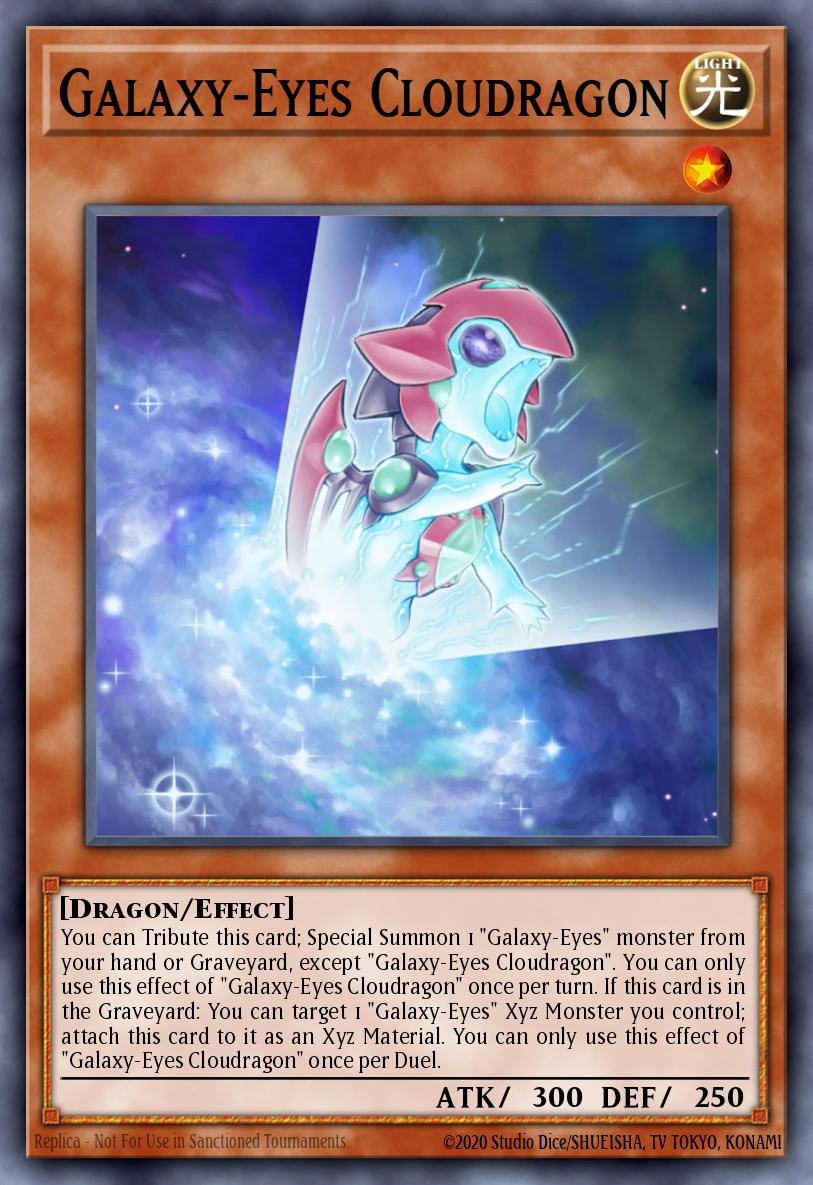
Galaxy-Eyes Cloudragon is a Level 1 that can tribute itself to summon GEPD from your hand or GY. It can also attach itself from the GY to a Galaxy-Eyes XYZ monster you control once per duel. Cloudragon is sometimes useful for un-bricking your hand. Unfortunately, it’s another monster that usually needs to be normal summoned.
1-Of : If you find yourself lacking starters, playing Cloudragon isn’t the worst choice in the world. It could also be a material for a potential Zeus.
0-Of : If you see any other normal summon of the deck, Cloudragon is usually a dead card.
Spells & Traps
Photon Sanctuary
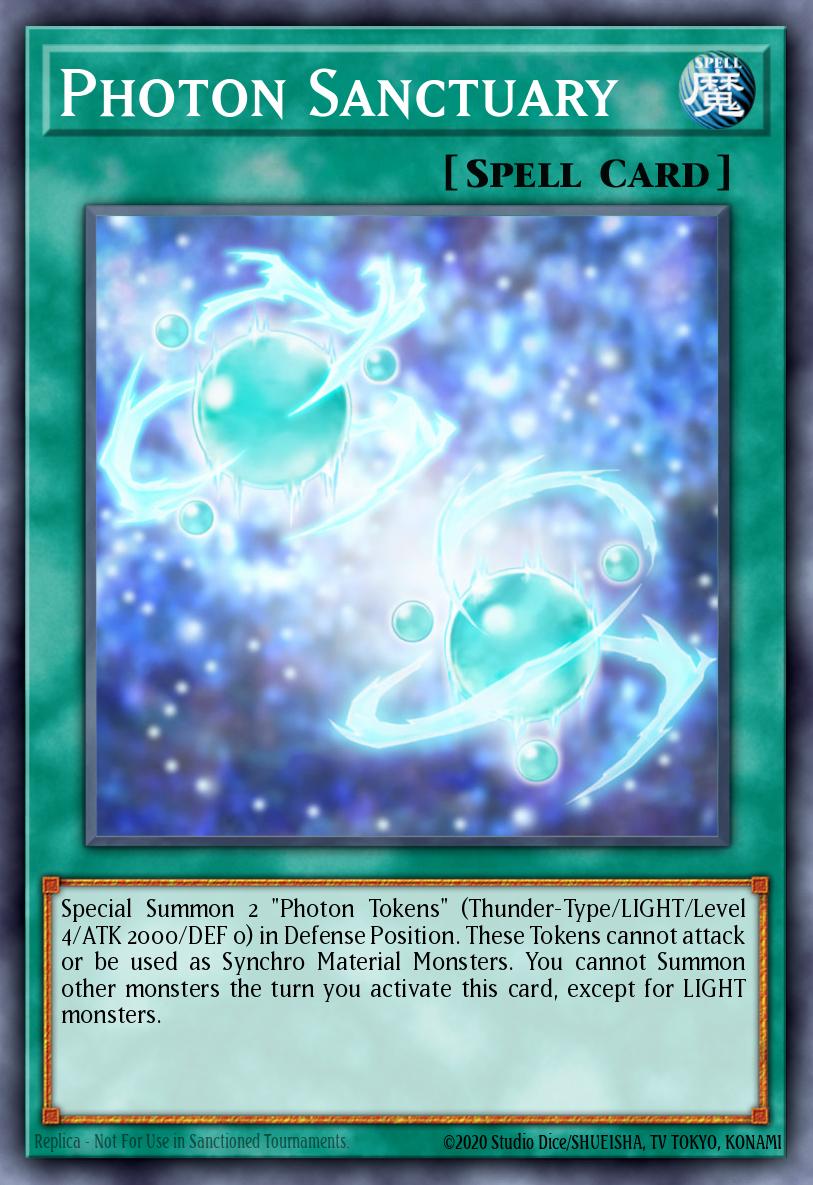
Photon Sanctuary is one of the archetype’s most powerful spells as it’s a Non-OPT spell that lets you summon 2 tokens. This lets you link into Union Carrier and Galaxy-Eyes Solflare Dragon using only one card. Sanctuary is also a starter as the tokens are Photon tokens. Having sanctuary makes it easy to link summon which makes monsters like Mekk-Knight Crusadia Avramax worth considering.
3-Of : Sanctuary is a card you definitely want to play at 3 because of its versatility. I want to play 4 of these if I could. It’s a starter, a 1-card Link 2 and you can even tribute the tokens to summon GEPD. Although it does have a restriction of being locked into LIGHT monsters, this is mainly irrelevant since you mostly only play LIGHT monsters anyways.
Galaxy Expedition
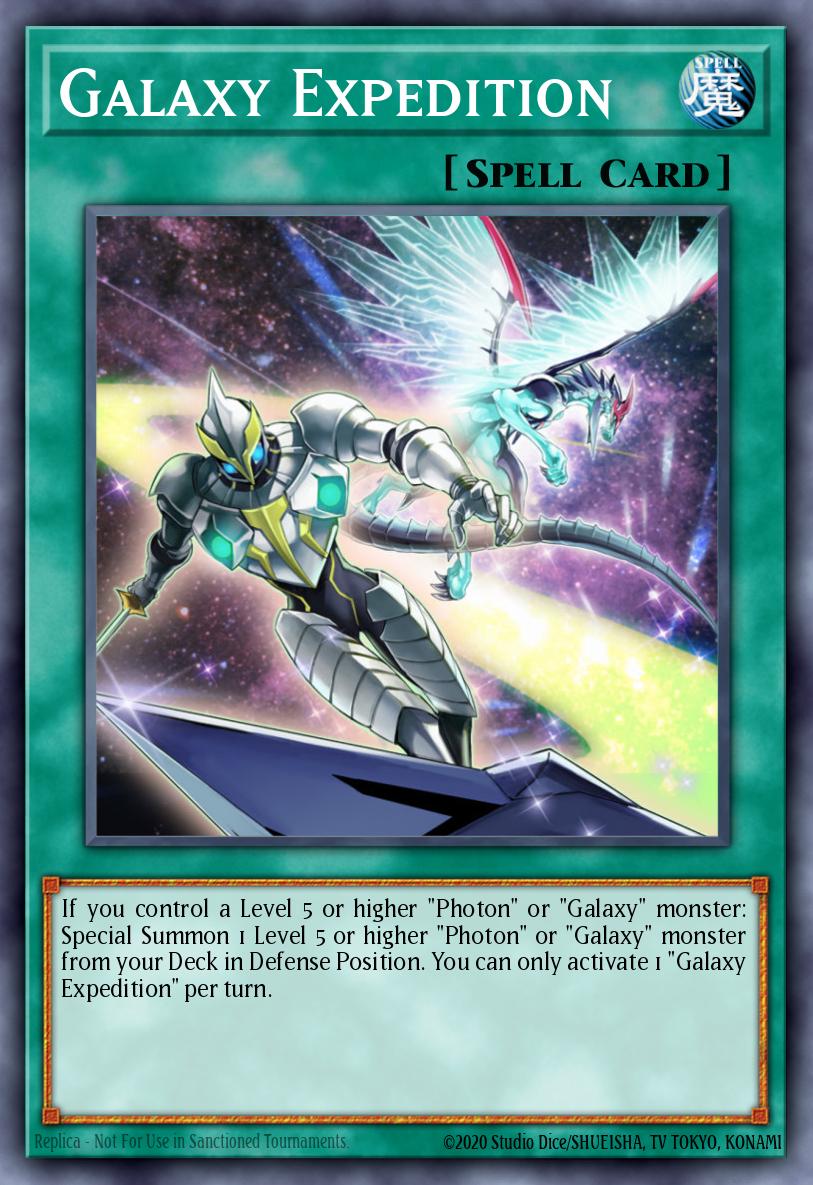
Galaxy Expedition is another powerful spell that lets you summon a Level 5+ Photon or Galaxy monster from your deck while you control a Level 5+ Photon or Galaxy monster. Expedition is best used to summon Galaxy Soldier as it will trigger Galaxy Soldier’s effect to search a Galaxy monster. Expedition can also summon Galaxy-Eyes Photon Dragon, Afterglow and even Knight if the situation calls for it.
3-Of : Expedition is a card you want to see and therefore should be played at 3. It’s usually a +1 because of Galaxy Soldier and can even get you Galaxy-Eyes Photon Dragon if you’ve failed to open one of the many cards that leads to it.
2-Of : If you want to follow the trend of playing 2 of the hard-OPTs, this is also fine. Seeing multiple expeditions in your opening hand does clog especially when it could have been a live card.
Galaxy Trance
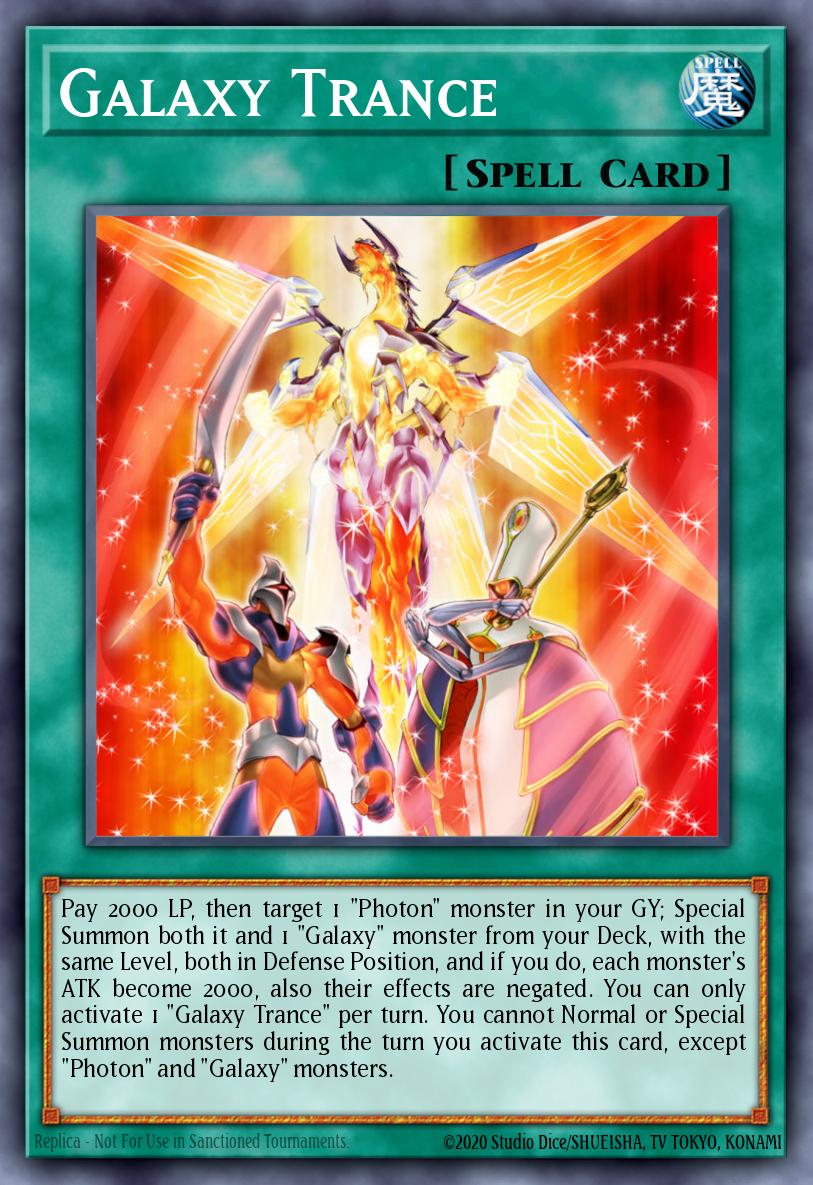
Galaxy Trance is a situational power spell that can generate a lot of pressure and value. Trance’s most common combo starts with summoning GEPD from your GY and Galaxy Knight from your deck. The combo then proceeds by linking into Solflare and using its effect to return Knight to your hand. Knight can then be normal summoned to summon GEPD and XYZ into a Rank 8. Though this is very powerful, Trance’s restriction to only summon Photon and Galaxy monsters is too steep of a drawback. With this limitation, you won’t be able to summon non-archetype cards such as Union Carrier or Divine Dragon Knight Felgrand.
3-Of : If you plan on playing a more pure build of Photon/Galaxy with less non-archetype cards, Trance is one of the best cards to play at 3.
1-Of : If you are playing a build that uses more non-archetype cards, Trance is better at 1. The problem with Trance in more non-archetype builds is that it both opens and closes many potential lines of play you may have. This requires a lot of calculation on which line of play is most efficient and it's often more work than it's worth.
Galaxy Zero
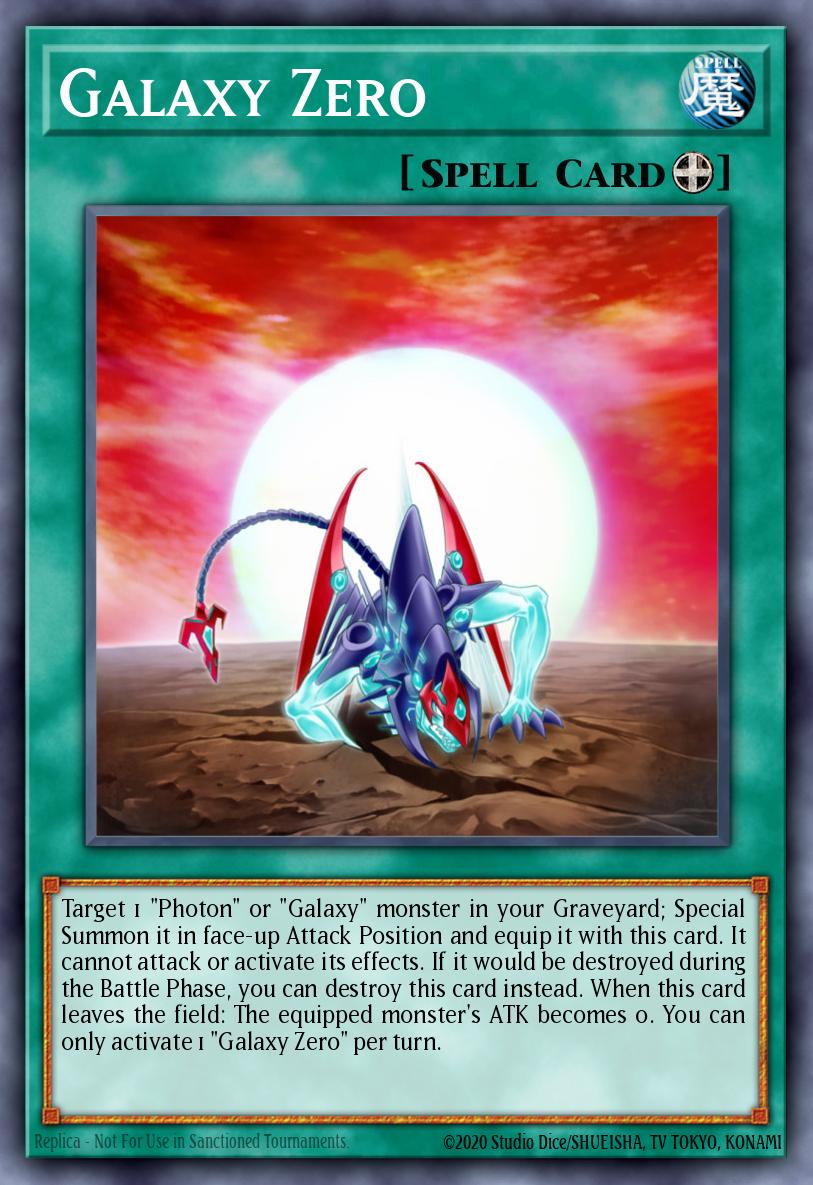
Galaxy Zero is an equip spell that revives a monster in your GY while restricting it from activating its effects and attacking. Zero is usually an extender since the monster summoned will be used for a Link or XYZ soon afterwards. One of the advantages to playing Zero is that it’s flexible since it can summon both Photon and Galaxy monsters. This gives you options as it acts as a variable combo piece. One of the disadvantages to this is that most monsters become XYZ materials rather than hit the GY. This might make it difficult for Zero to summon a monster with the requirements you need.
1-Of : Zero is an option at 1 if your build can utilize it effectively.
0-Of : If not, Zero should be cut in place of a better extender.
Photon Hand
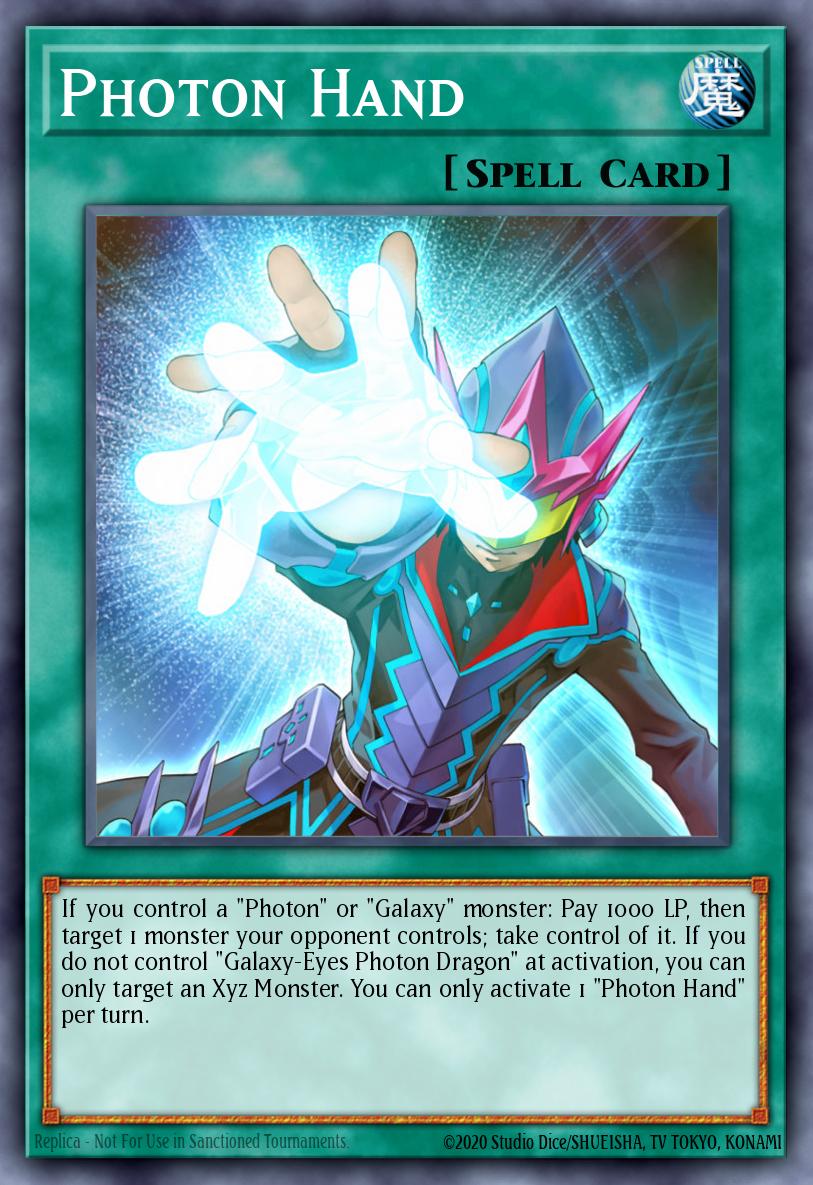
Photon Hand is a spell that permanently takes one of your opponent’s monsters if you control GEPD. If you do not control GEPD, you can only take XYZ monsters. Hand is a weird card that doesn’t follow the theme of the archetype. While taking an opponent’s monster is good, the archetype doesn’t struggle with getting through monsters to begin with. Basically, I'd rather kill your monsters and kill you rather than take your monsters for advantage. This means Hand will likely be used to bait a negate. If it doesn’t, then the position is probably winning anyways and Hand could have been a superior extender. In the current meta, Hand can be useful to steal monsters like Vanity's Ruler and Invoked Mechaba.
1-Of : If you want to “cheese” your opponent or play this as a tech, playing Photon Hand at 1 is fine. It's a card that will often catch your opponent off-guard since it's widely overlooked and sees little play.
0-Of : If you want the option to go first whenever possible, Photon Hand should not be played since it doesn’t do anything when going first.
Photon Change
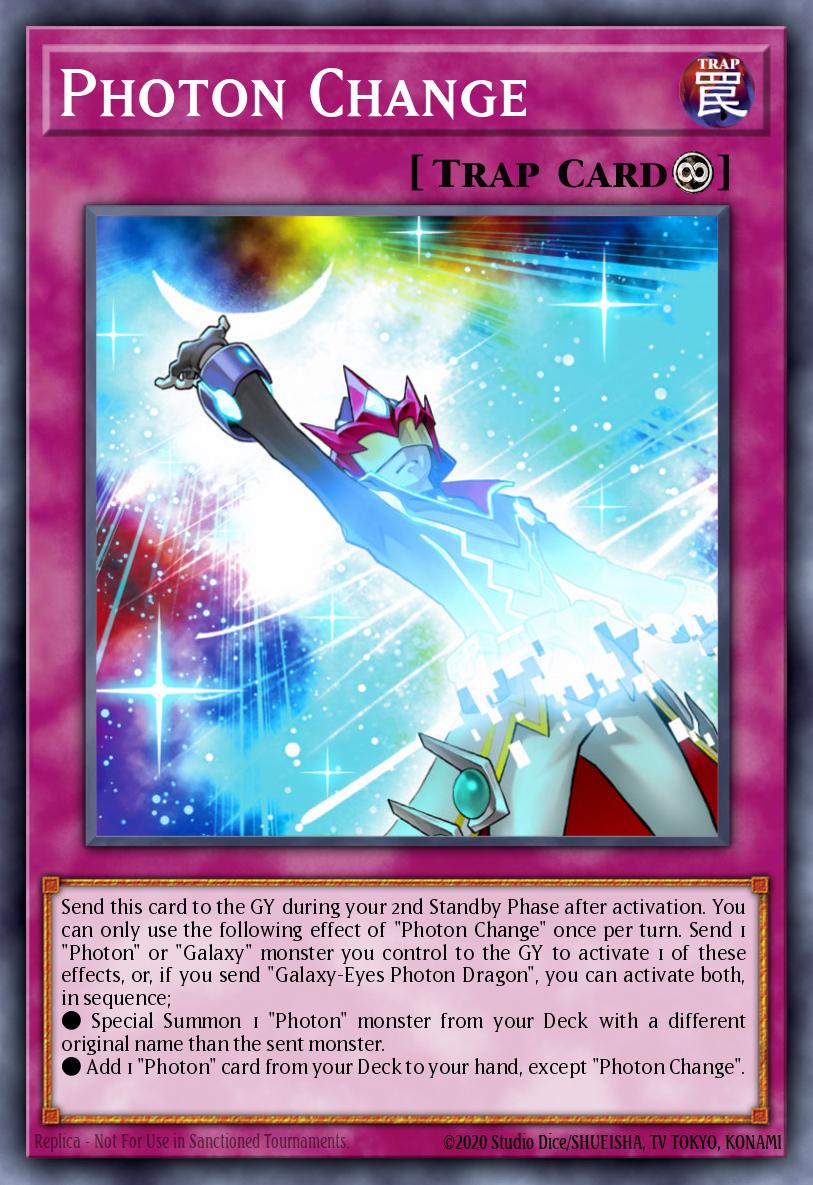
Photon Change is a continuous trap that cycles Photon and Galaxy Cards by sending a Photon and/or Galaxy monster you control to the GY. I really wish this was a continuous spell over a continuous trap because the card’s effect is actually really good. Change not only replaces the sent monster but can also searches a Photon card to your hand. This helps you setup for following turns while also generating value. Change is also one of the few cards that can search Photon Sanctuary. However, due to it being a trap, it’s too slow for a meta where you need every card to have immediate value.
1-Of : If you’re playing in a slower meta, Change can be played at 1.
0-Of : If you’re playing in a faster meta, you should cut Change because you won’t have enough time to take advantage of the card. Change's problem is that it doesn't start generating value until turn 3 where a game with Photon/Galaxy is already decided.
Tachyon Transmigration
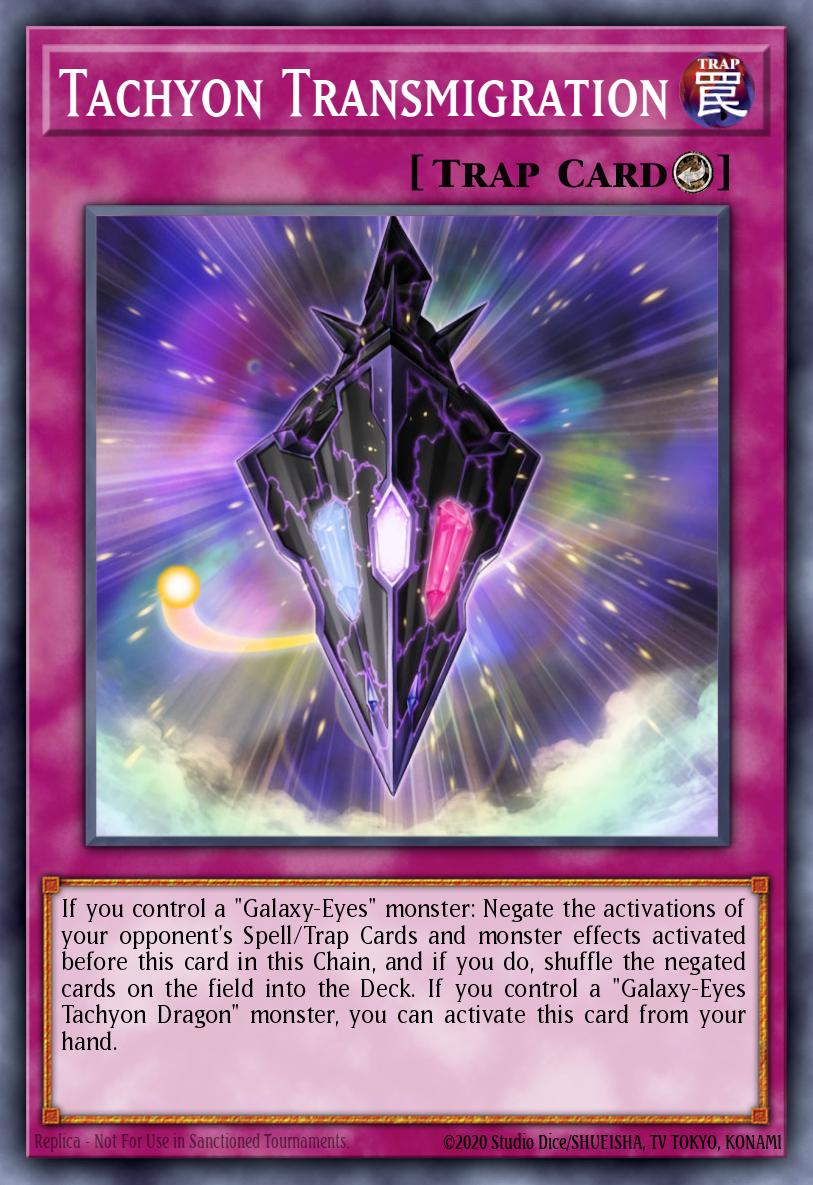
Tachyon Transmigration is a crazy counter trap that can be activated if you control a Galaxy-Eyes monster. When activated, it negates all of your opponent’s effects in the same chain and shuffles cards on the field into the deck. This card is amazing against decks that create long chains such as Prankids and can really mess up your opponent’s plans. Even if it doesn't get full value, it's still an Omni-negate. Transmigration can also be activated from the hand if you control Tachyon Dragon which is sometimes relevant as it can help you steal wins and play through disruptions.
3-Of : Transmigration should be played at 3 since it’s one of the best cards to open. It’s a non-OPT that is also a counter trap with an easy activation condition. When going second, Tachyon Transmigration can help Tachyon Dragon stick to the board through Battle Phase letting you make a Zeus afterwards if necessary.
Extra Deck
Galaxy-Eyes Solflare Dragon
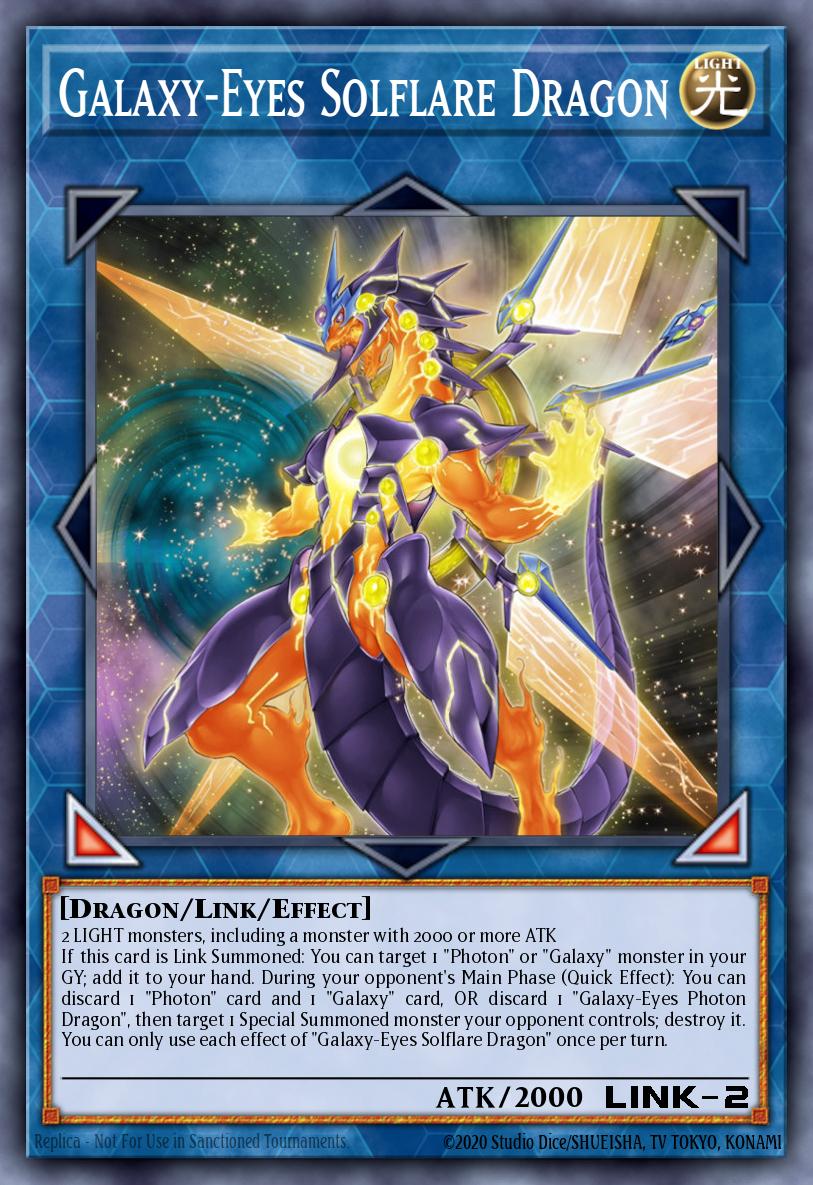
Galaxy-Eyes Solflare Dragon is the Link of the archetype and has both a recovery and disruption effect. Upon being link summoned, Solflare can return 1 Photon or Galaxy monster from your GY to your hand. Solflare can also destroy a special summoned monster during your opponent’s main phase by discarding 1 Galaxy and 1 Photon card or 1 GEPD.
2-Of : Playing Solflare at 2 is the most common ratio since it gives you a recovery option past turn 1. This lets you fetch Galaxy Knight for follow-up plays after your opening turn.
1-Of : If you feel like you lack space in the extra deck, Solflare can also be played at 1. This lets you have a more extra deck options but limits your recovery mid-game. However, this usually isn't a problem since Photon/Galaxy games don't last too long anyways.
Starliege Photon Blast Dragon
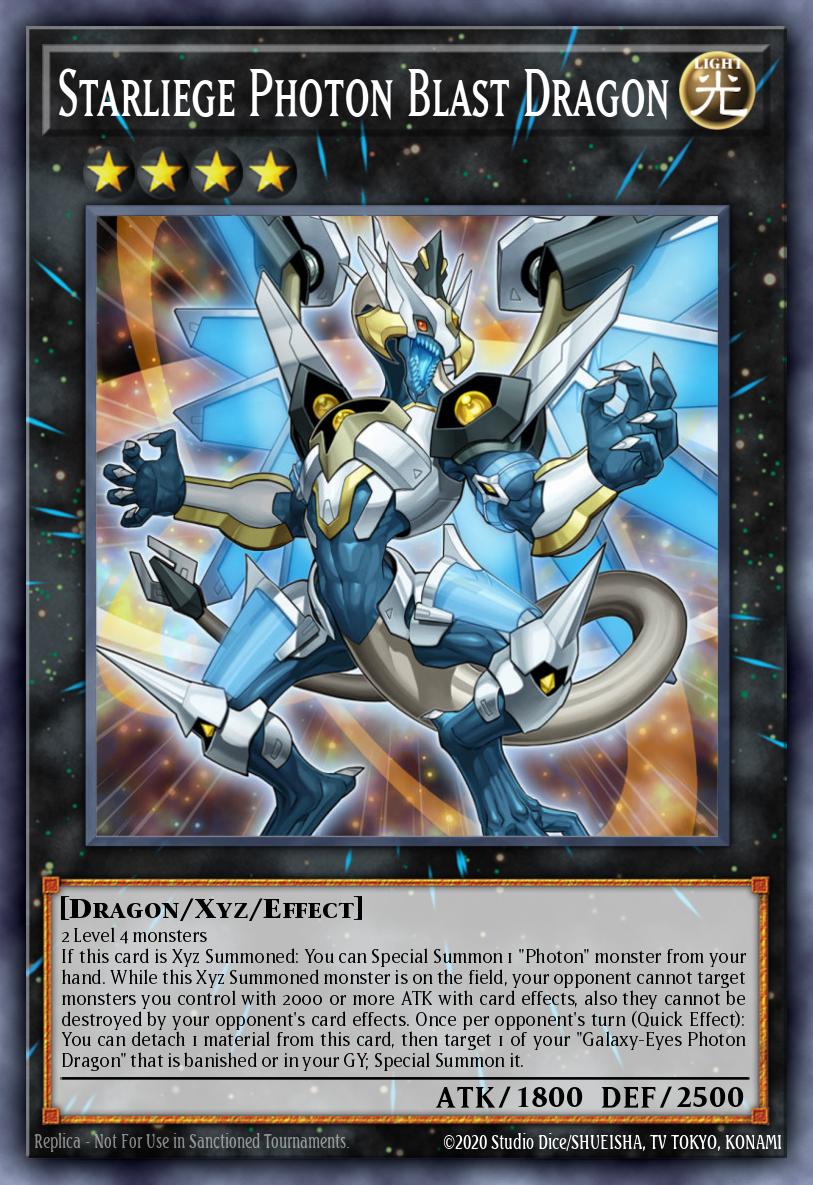
Starliege Photon Blast Dragon is a Rank 4 XYZ that contains multiple good effects. For starters, Blast Dragon summons 1 Photon monster from your hand if it is XYZ summoned. If it's XYZ summoned, it also applies an aura effect which prevents your monsters with 2000+ ATK from being targeted and destroyed by your opponent’s card effects. This is good because it means when Blast hits the board successfully, the rest of your play will usually go smoothly (if you don't get hit by a rock). Blast Dragon also has a 3rd effect which summons Galaxy-Eyes Photon Dragon from your GY or banished zone during your opponent’s turn.
1-Of : Blast Dragon should be played at 1 because it's difficult to summon after your first turn. This is because after turn one, you'll usually only be making Rank 8s to fight for board or trying to kill your opponent.
Starliege Lord Galaxion
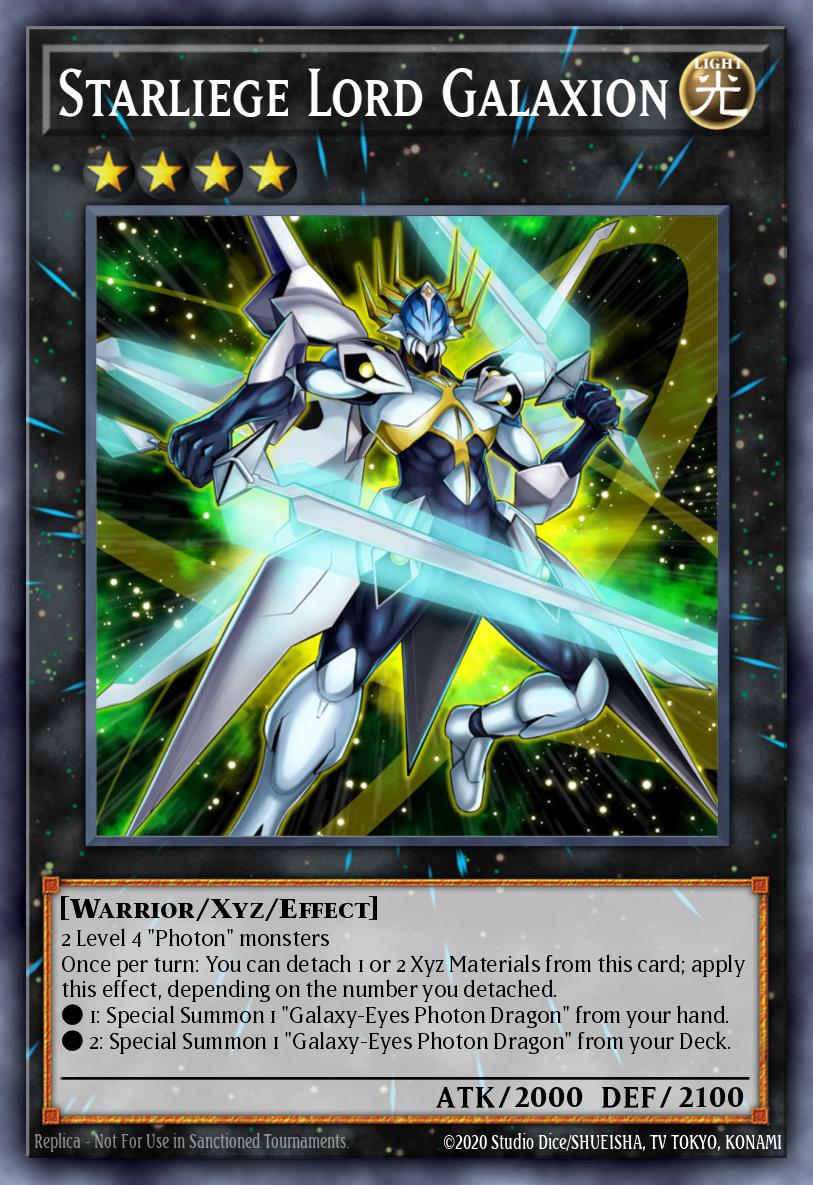
Starliege Lord Galaxion is a Rank 4 XYZ that can summon GEPD from your hand or deck. While this is a beneficial effect, it doesn’t do as much as Blast Dragon and usually isn’t strong enough to warrant an Extra Deck slot. Its summoning conditions are also more restrictive than Blast Dragon, specifying 2 Photon monsters. Galaxion sees play when playing more niche cards such as Galaxy Cleric and Chaos Dragon Levianeer as it’s good at filling your GY.
1-Of : If you want to play Cleric, Levianeer or you're struggling to see GEPD, Galaxion is an alright option to fill those needs.
0-Of : Galaxion's problem is that it doesn't do anything after tutoring a Dragon. If you don't plan on playing cards that synergize with a loaded GY, don't play Galaxion.
Neo Galaxy-Eyes Photon Dragon
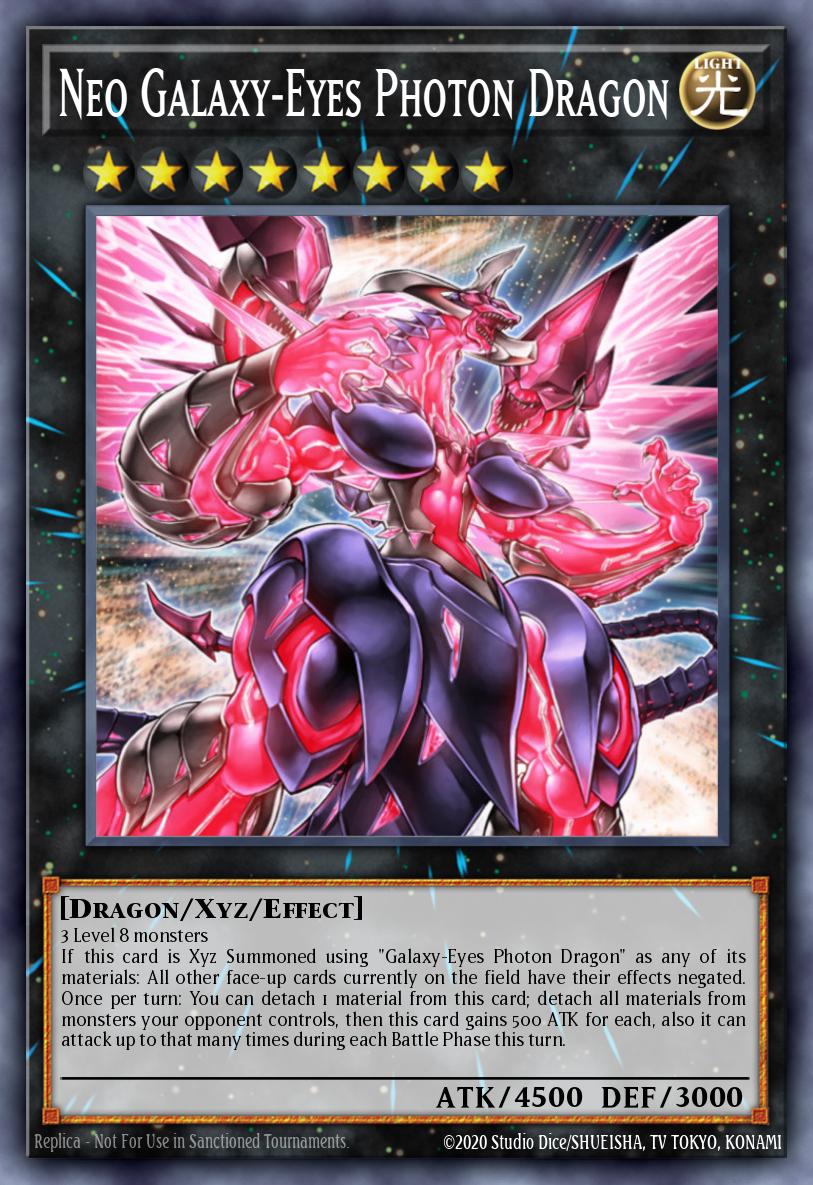
Neo Galaxy-Eyes Photon Dragon is a Rank 8 XYZ that specializes in countering XYZ monsters. Its effect where if it’s summoned using GEPD as material, negates all other face-up cards currently on the field. It also has another effect that lets it “absorb” your opponent’s XYZ materials to power up and gain additional attacks during the battle phase.
1-Of : Neo Photon shines brightest in metas where there are an abundance of XYZ monsters. Consider playing this at 1 if your locals has many XYZ players.
0-Of : Neo Photon unfortunately doesn’t do much when there are no XYZs on your opponent’s field. If you don’t see yourself playing against many XYZ players, don’t play this card.
Number 90: Galaxy-Eyes Photon Lord
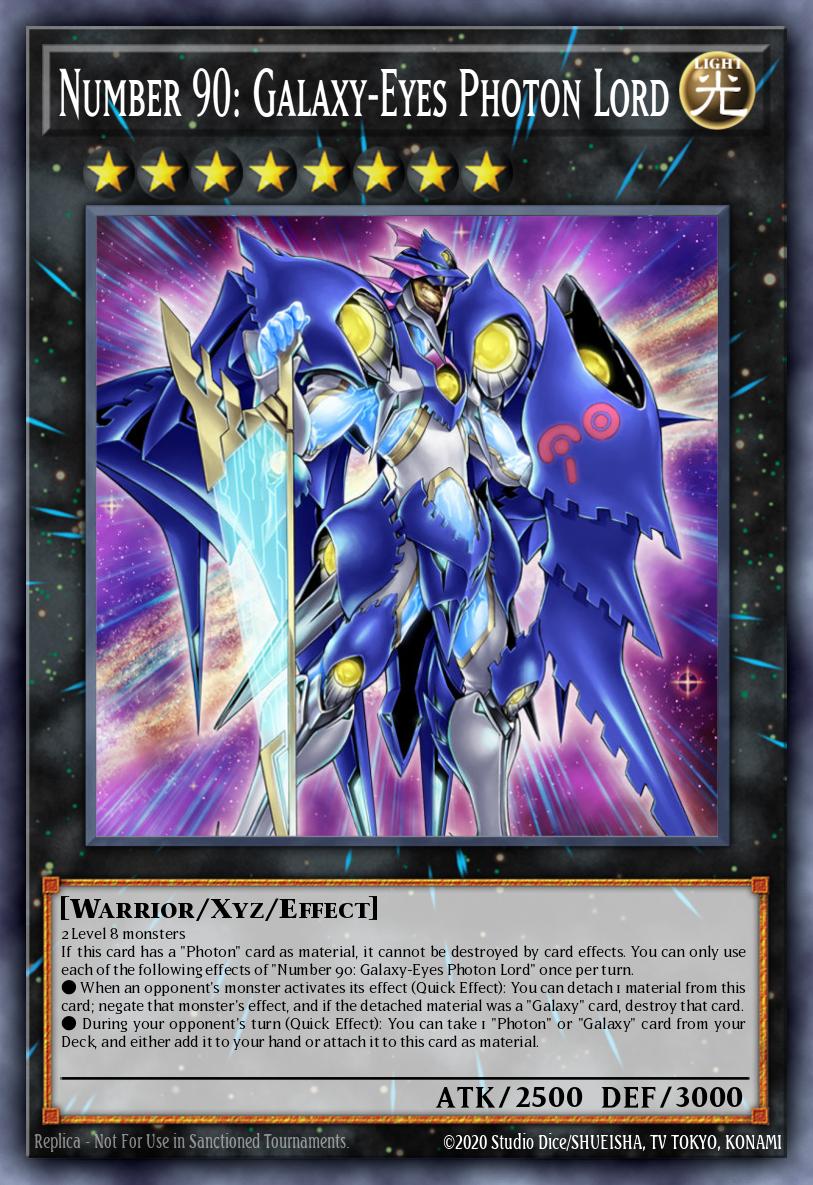
Number 90: Galaxy-Eyes Photon Lord is a Rank 8 XYZ that you’ll most likely be ending on the most. It has a built in protection effect while it has a Photon card as material and 2 additional effects that are great for the archetype. Photon Lord’s first effect lets you detach 1 material to negate a monster effect and destroy it if you detached a Galaxy card. Since Photon Lord will usually be summoned using Galaxy Knight and/or Dragon as material, this is an easy condition to meet. Photon Lord also has another effect that lets you take 1 Photon or Galaxy card from your deck and add it to your hand, or attach it to Lord as a material. Again, I wish this effect is active during both turns but this doesn’t take away from Photon Lord being a great card.
2-Of : Photon Lord is one of Photon/Galaxy’s best XYZs and is great for longer games as it provides a strong body with repeating value. Playing it at 2 is perfect for slightly more drawn out games.
1-Of : In games that you expect to be shorter, one Photon Lord is enough.
Number 62: Galaxy-Eyes Prime Photon Dragon
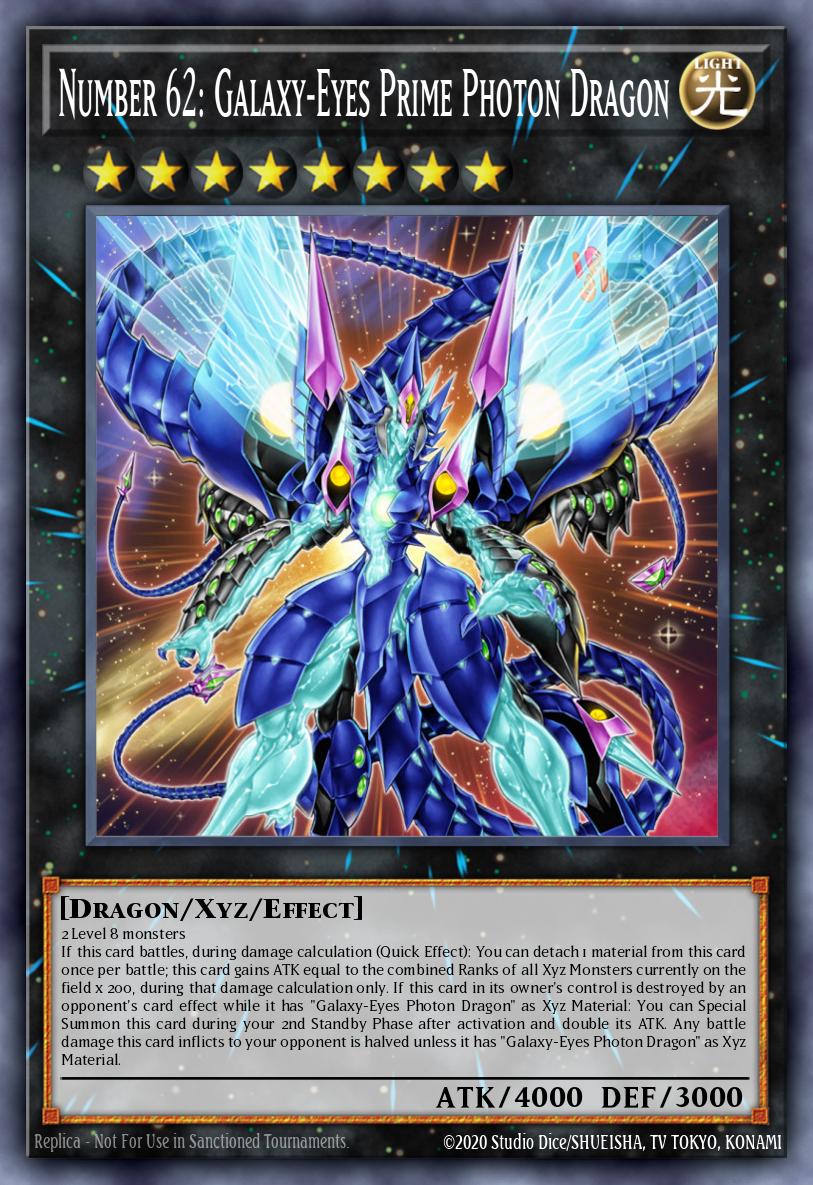
Number 62: Galaxy-Eyes Prime Photon Dragon is a Rank 8 XYZ and the OTK battering ram of the deck. When used with Afterglow, Prime Photon’s ATK can become 11,200 which can end games in an instant. Since Prime Photon activates during damage calculation, it prevents your opponent from using Ash Blossom to negate your Afterglow. Prime Photon also has a nifty effect that re-summons itself 2 Standby phases after it’s destroyed by an opponent’s card effect. This effect, although rarely used can catch your opponent off guard when an 8,000 ATK Dragon returns to the field 2 turns later.
1-Of : Prime Photon should be played at 1 to have as an option to OTK your opponent. With 11,200 ATK, it can easily wipe out your opponent’s Life Points without needing to attack directly. If you need to summon Prime Photon more than once in a game, then something went terribly wrong.
Number 107: Neo Galaxy-Eyes Tachyon Dragon
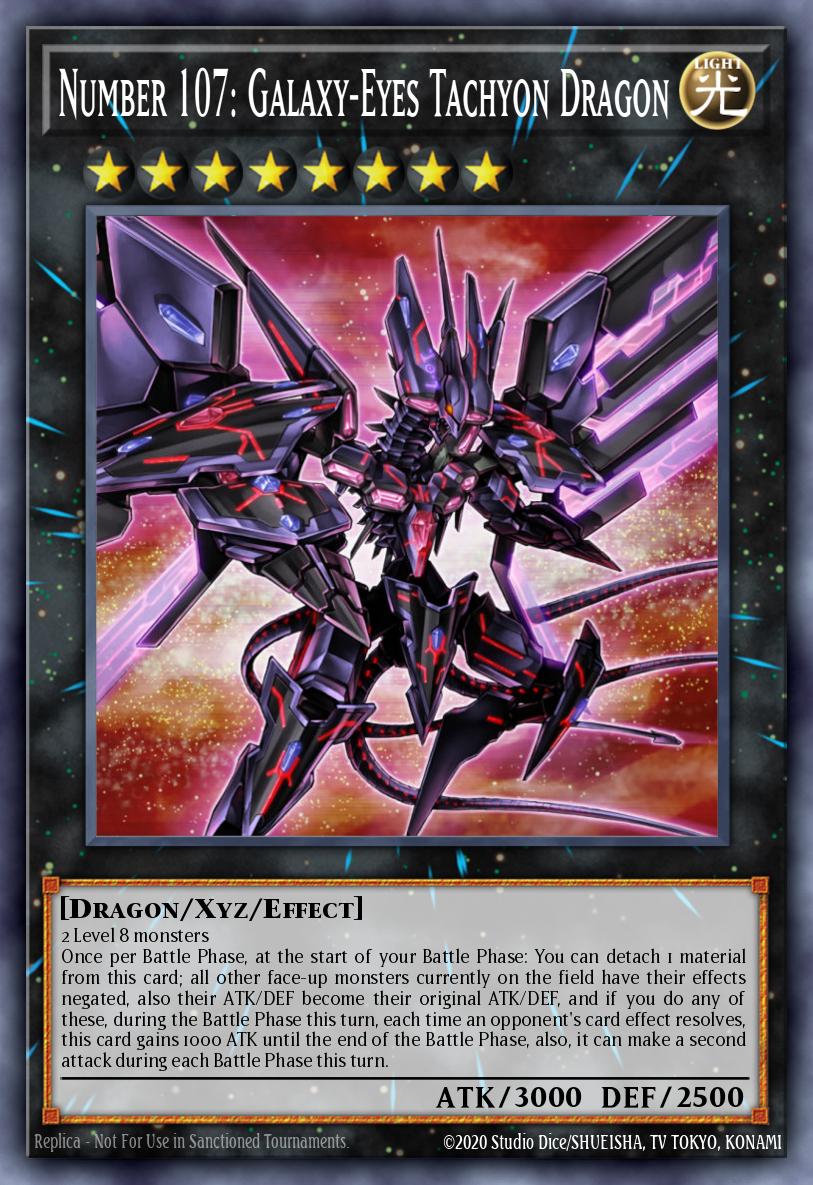
Number 107: Galaxy-Eyes Tachyon Dragon is a Rank 8 XYZ that was used by Mizeal in the Yu-Gi-Oh anime. It has an effect that activates during the battle phase which negates the effects of all other face-up monsters currently on the field. This effect also changes monsters stats to their originals and makes Tachyon gain 1000 ATK and a second attack if your opponent resolves an effect. Tachyon is used in conjunction with Tachyon Transmigration as you can activate it from your hand if you control Tachyon. It’s also an option for OTKs with Afterglow as if your opponent resolves a card effect, Tachyon can attack twice for heavy damage. If that’s not enough, Afterglow will summon a Galaxy-Eyes Photon Dragon which will often wipe out the rest of your opponent’s life points.
1-Of : Tachyon’s slot in the extra deck is dependent on what other cards you choose to play alongside it. Since the extra deck can go down many paths, Tachyon can come in and out depending on which finisher you decide to play.
Number 38: Hope Harbinger Dragon Titanic Galaxy
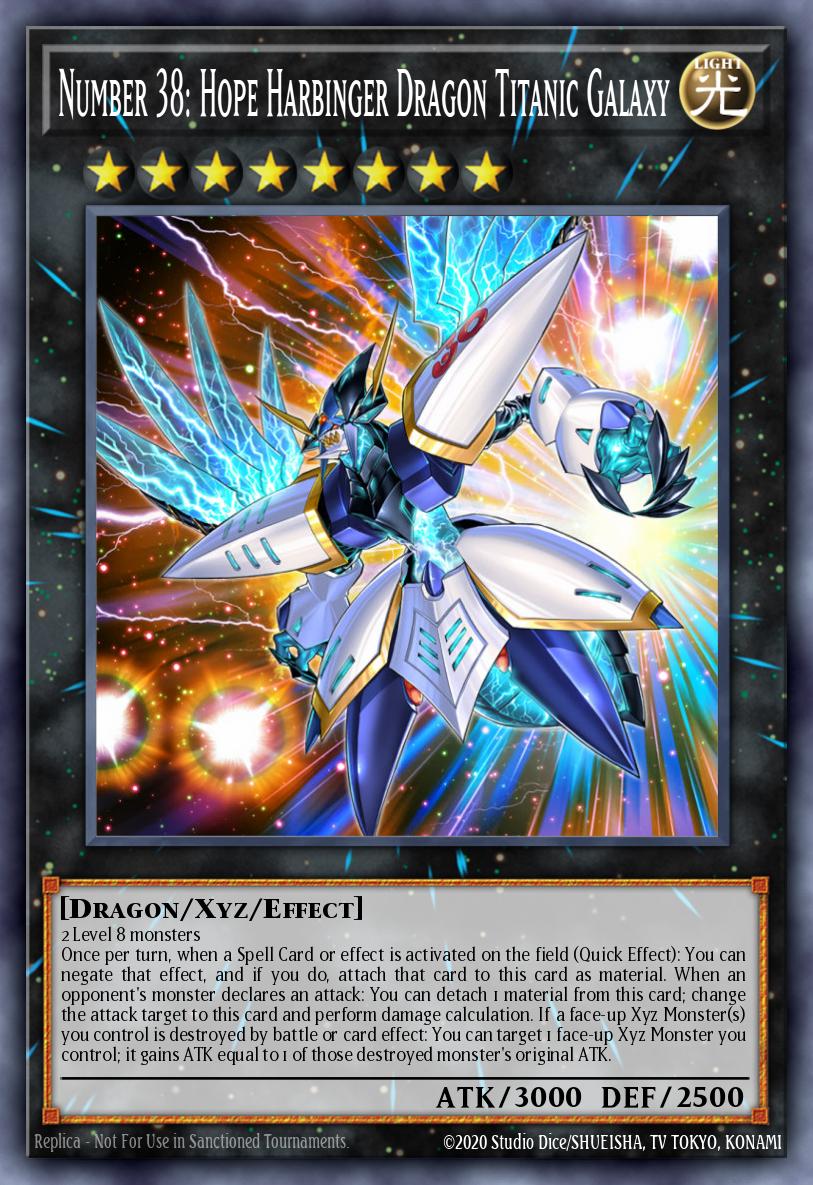
Number 38: Hope Harbinger Dragon Titanic Galaxy is a Rank 8 XYZ that can negate the effect of spells and attach them to itself as XYZ material. It also has another effect that redirects your opponent’s attacks to itself by detaching an XYZ material. Harbinger is mainly used when playing against spell heavy decks and also helps protect your other monsters from attacks. It also has another effect that gives XYZ monsters you control ATK if another XYZ monster you control is destroyed by battle or card effect. People often forget about this effect which could lead to your opponent making mistakes during battle.
1-Of : Harbinger is a strong individual card that is a solid option depending on matchup. It’s also useful for protecting your weaker monsters such as Blast Dragon.
Galaxy-Eyes Cipher Dragon
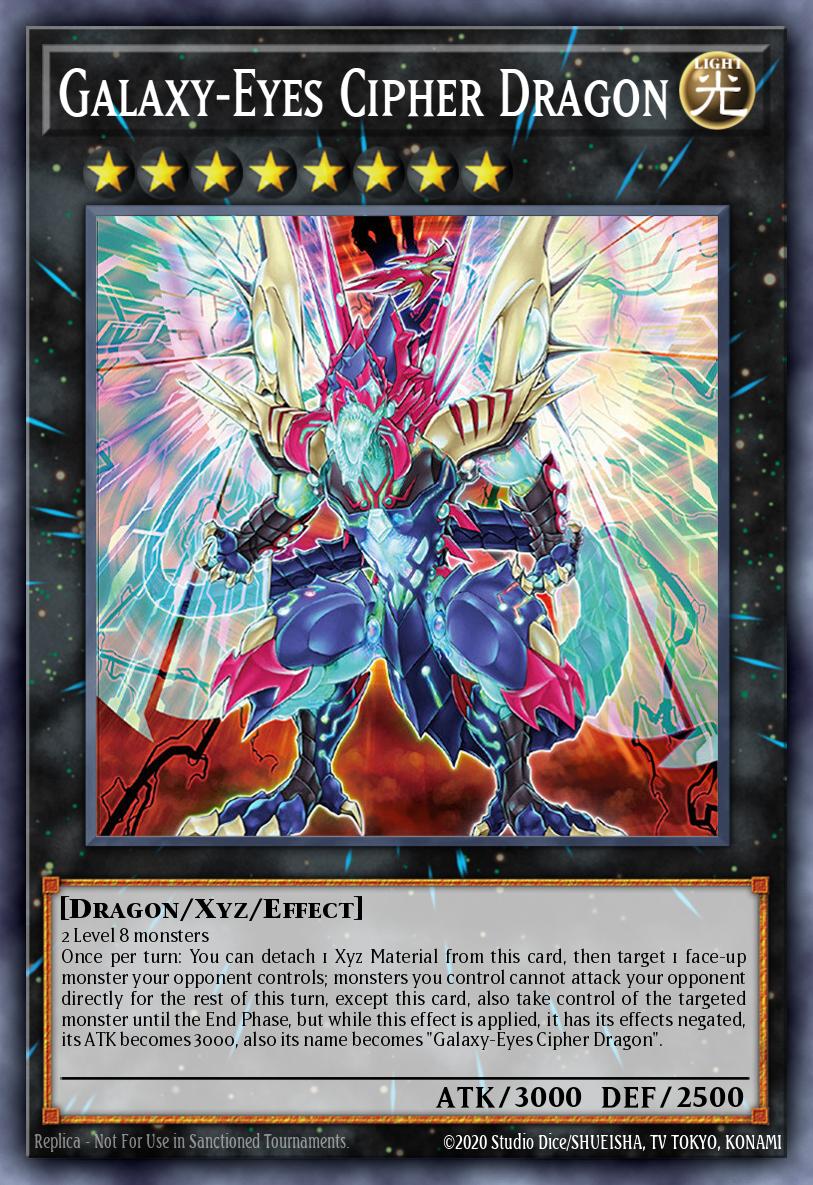
Galaxy-Eyes Cipher Dragon is a Rank 8 XYZ that can take your opponent’s monster and change its stats and name. This effect is useful when you want to use your opponent’s monster for a XYZ summon and don’t want it in the GY. The most common way to do this is to take an opponent’s monster and then XYZ one of your Dragons over it. Cipher’s effect is rather niche as you usually won’t be able to OTK the turn you use its effect. It’s also sometimes difficult to use the monster you take, as most of your “Rank-Up” Galaxy XYZ monsters require the monster used as XYZ material to be an XYZ monster. This problem is fixed with the release of Cipher EX dragon that does not have this restriction.
1-Of: Cipher is played at 1 for matchups where you fight for control of the board.
0-Of : The problem with Cipher is that it’s too slow for the meta. Since most meta decks can combo off 1 or 2 card(s), you would usually prefer to end the game over gaining small advantages.
Galaxy-Eyes Cipher Blade Dragon
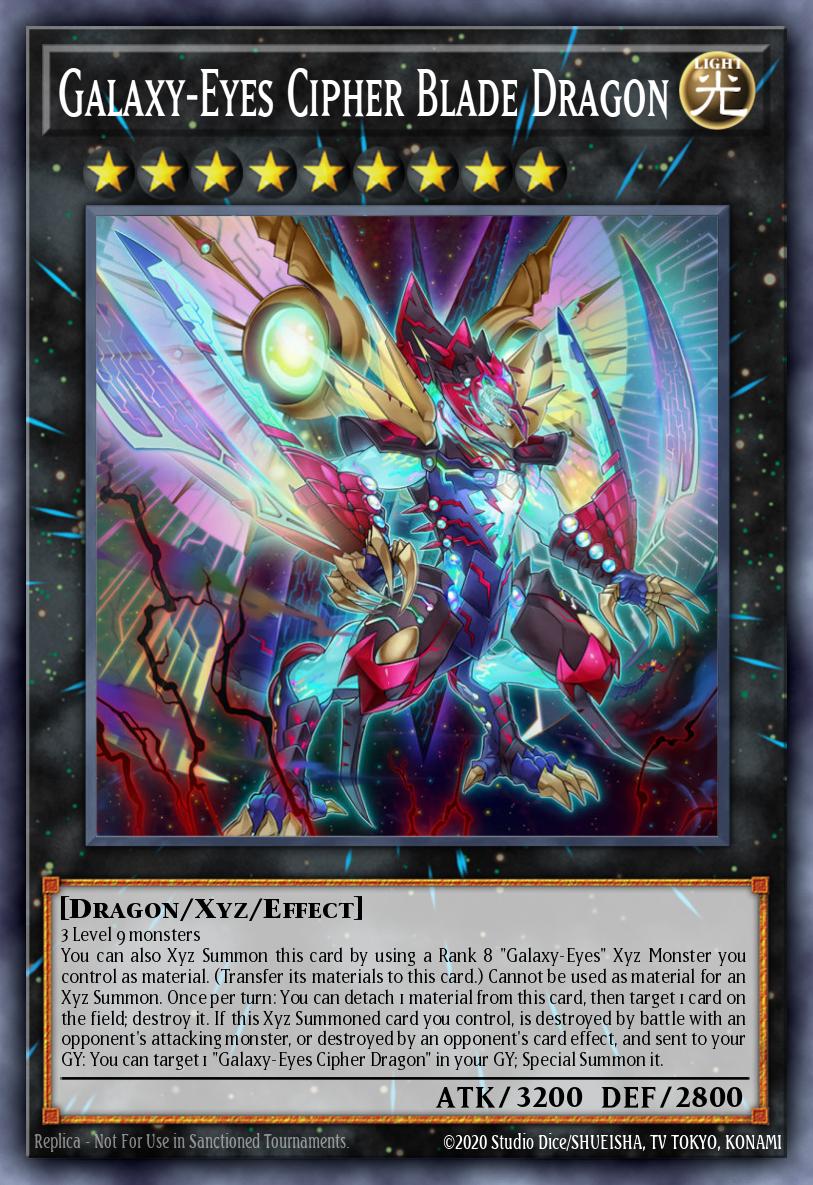
Galaxy-Eyes Cipher Blade Dragon is a Rank 9 XYZ that can be summoned using a Rank 8 Galaxy-Eyes XYZ monster as material. It provides an extra destruction effect and should usually be summoned towards the end of your combo. This is because while some of your other monsters can be used as XYZ material, Cipher Blade cannot. Cipher Blade also has an effect where if it’s destroyed, you can summon Cipher Dragon from your GY.
1-Of : Cipher Blade Dragon is a solid card providing free destruction. You can consider playing 1 if you also plan on playing Cipher Dragon since they have some synergies.
0-Of : If you aren't playing Cipher, you probably don't need this either. Full Armor is usually enough and this could be a different Rank 8.
Galaxy-Eyes Full Armor Photon Dragon
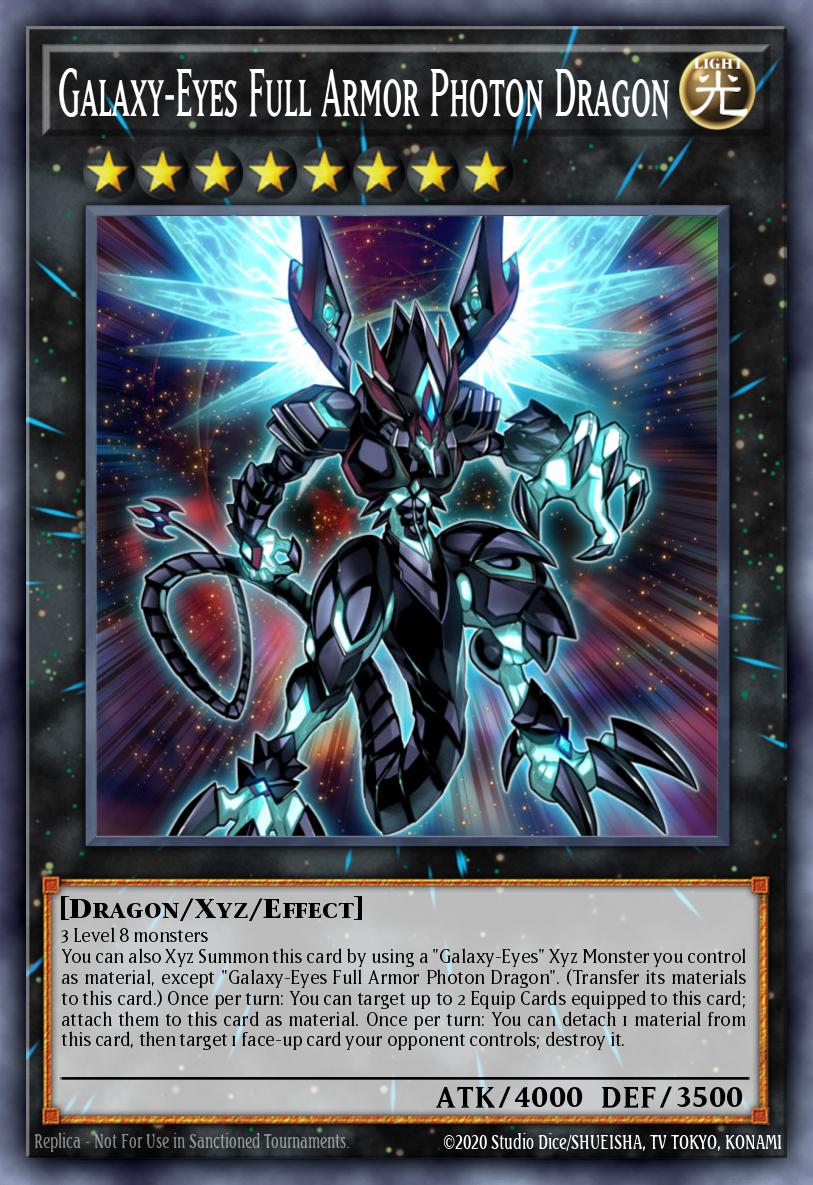
Galaxy-Eyes Full Armor Photon Dragon is a Rank 8 XYZ with a similar effect and summoning condition to Cipher Blade. It has an easier summoning condition, requiring a Galaxy-Eyes XYZ monster but a weaker effect as it can only destroy face-up cards. Full Armor has strong stats with 4000 ATK and can be used to XYZ into Cipher Blade.
2-Of : In rare instances where 1 isn't enough, Full Armor is okay at 2. Having 2 makes it easier to grind and also gives Galaxy Brave a 4000 ATK target in the GY.
1-Of : Full Armor should be played at 1 due to its high ATK and free destruction effect. It’s also an extra material for Zeus If you choose to play it.
Galaxy-Eyes Cipher EX Dragon (TCG Name not confirmed)
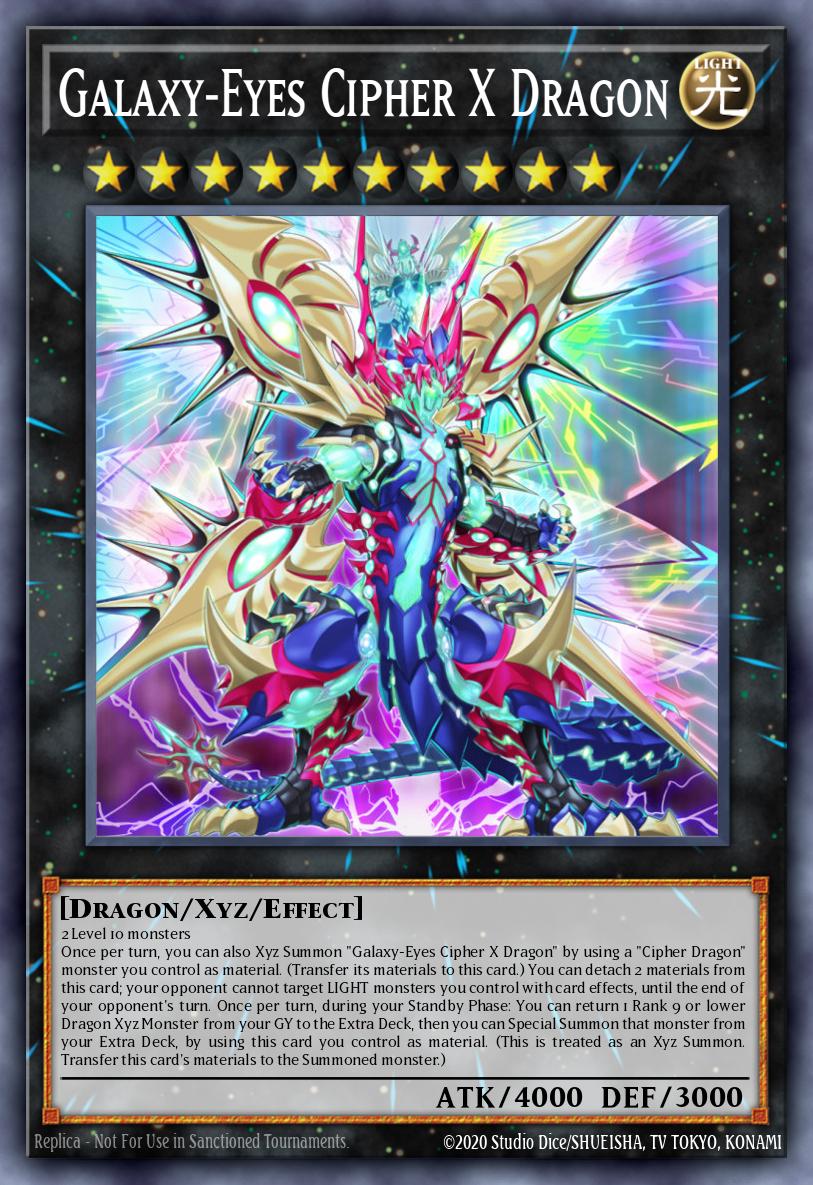
Galaxy-Eyes Cipher EX Dragon is a Rank 10 XYZ monster that can be summoned using a Cipher Dragon as XYZ material. Cipher EX makes normal Cipher better as it can be summoned on top of the monster you take with Cipher. It can also detach 2 materials to prevent your opponent from targeting LIGHT monsters you control with effects until the end of the turn. If Cipher EX survives until the next standby phase, it can also return 1 Rank 9 or lower Dragon XYZ from the GY to the extra deck and then summon it on top of Cipher EX.
1-Of : In theory, Cipher EX seems like a good card to play at 1 if you were to play the original Cipher. You can also XYZ Cipher Blade on top of this.
?-Of : Since Cipher EX has not been released in the TCG, I have not had the opportunity to test this card in-game.
Non-Archetype Cards to Consider / Honorable Mentions
Staples
Staples such as Reinforcement of the Army, Monster Reborn and Harpie’s Feather Duster go without saying as some of the best options you can play in a Photon/Galaxy deck. ROTA is a flexible card that can search for a missing combo piece. Reborn is a solid extender that’s good going first and second. And Feather Duster is great for removing annoying backrow.
Trade-In
Since you play a lot of Level 8s, Trade-In is good for improving consistency and cycling cards. Trade-In is ideally used to discard GEPD which is free from Vanisher.
Guardian of Order
Guardian of Order is a Level 8 LIGHT extender that can be summoned if you control 2 or more LIGHT monsters. It’s a solid monster if you want more cards that XYZ into Rank 8.
Diana the Light Spirit
Diana the Light Spirit is a Non-OPT Level 4 LIGHT that can be summoned by banishing 1 LIGHT monster from your GY. This acts as an extender that helps you XYZ into your Rank 4s and Link 2s.
Union Carrier
Union Carrier is a Link 2 that helps you get to Photon Orbital. It’s great since it can easily be summoned off Photon Sanctuary and also pumps the attack of your monsters. Although Carrier’s main purpose is getting Orbital, it can also equip a card to Blast Dragon making it 2800 ATK.
Hip Hoshiningen
Hip Hoshiningen is a Link 2 LIGHT monster that buffs the stats of LIGHT monsters while nerfing the stats of DARK monsters. You can play this if you don’t have access to a better option for your extra deck.
Cyber Dragon Nova + Cyber Dragon Infinity
The Cyber Dragon XYZ package consists of Cyber Dragon Nova and Cyber Dragon Infinity. This package is a solid option that you can summon easily off Galaxy Soldier. The downside to this package is that it takes 2 slots from an already tight Extra Deck.
Constellar Pleiades
If you decide that 2 slots for the Cyber Dragon XYZ package is too much, Constellar Pleiades is a good alternative. While it doesn’t negate, it does offer a bounce which sometimes can be enough to stop your opponent’s play. Though it’s not as powerful as Infinity, it allows more room in your extra deck to play a higher variety of cards.
Number 68: Sanaphond the Sky Prison
Number 68: Sanaphond the Sky Prison is a Rank 8 that prevents your both players from summoning from the GY until the end of your opponent’s turn. Sanaphond is a solid option if the meta is heavy in summoning from the GY. It also has decent stats since it gains 100 ATK/DEF for each monster in the GY.
Number 97: Draglubion + Number 100: Numeron Dragon + Number C107: Neo Galaxy-Eyes Tachyon Dragon
The Number 97: Draglubion package is played as a 2 card OTK where your options include Number 100: Numeron Dragon and Number C107: Neo Galaxy-Eyes Tachyon. Numeron Dragon is a monster that gains ATK equal to 1000 x the combined Ranks on the field. This makes Numeron Dragon at least 9000 ATK with the potential of being higher. Neo Tachyon negates and prevents your opponent from activating effects on the field. However, Neo Tachyon also requires a steeper cost for its effect and has less ATK than Numeron Dragon. In my opinion, Numeron Dragon is better than Neo Tachyon, but you can play the card you like more.
Divine Dragon Knight Felgrand
Divine Dragon Knight Felgrand rises to prominence once again with the release of Afterglow. Felgrand is the only LIGHT Rank 8 that can detach on demand with a semi-disruption effect. This makes it one of the best options to make use of Afterglow’s extender effect that summons GEPD.
Divine Arsenal AA - Zeus - Sky Thunder
Divine Arsenal AA-ZEUS - Sky Thunder is a Rank 12 that you can summon if an XYZ monster battles this turn. The best way to bring out Zeus is to use Tachyon during the battle phase to secure you an attacking monster and follow up with Full Armor into Zeus. If you have other monsters like Cleric or Cloudragon, they can also become extra materials before summoning Zeus. Zeus is a good way to clear the board when going second and in the mid-game. However, since Zeus is a one of the more expensive cards on this list, feel free to play something else if you can’t afford it.
Design Issues and Going Forward
Personally, I feel that cards like Photon Change and Eternal Galaxy would be much better if they were spells over traps. I also think if Photon Lord and Blast Dragon could activate all their effects during both turns, it would help the archetype a lot. Another issue is that your Photon/Galaxy spells are often your most impactful while also being the hardest to get to since it’s too difficult to search manually going first. One way to solve this is by giving the deck additional normal summons which would give more incentive to summon Galaxy Wizard. While the archetype continues to get support in the future, I hope some of these concerns would be addressed to make the archetype better moving forward.
Conclusion
Overall, Photon/Galaxy is an archetype that I play personally because I enjoy the playstyle and like the cards. The artwork on some of the cards (especially in the ultimate rare prints) is rather beautiful to look at and I have a personal affection to cool looking Dragons. It also has a “unique” play-style with lots of interesting cards and cool combos. Although this archetype isn’t something I’d ever expect to be “competitive,” it’s still something that I find fund to play. With the release of Legendary Duelists: Season 2, many of the previous expensive cards have been made much cheaper. I encourage you to try the deck out and see what you can come up with!
Video Counterpart
This article has a Youtube counterpart which explains most of the things mentioned in this article vocally. Some topics are discussed more in-depth while others are not. If you feel like this is too long of an article for you to read, please consider checking out this video that took excessively long to make (WARNING: It's a long video, so maybe keep it running as background music while you do something else). A deck profile of my personal build is also included with its card choices and ratios explained. If you want to check it out, the link can be located below! Thanks for Watching!
https://www.youtube.com/watch?v=MrgqnCACEkc&ab_channel=BlueRainTCG



